The Sundance Film Festival is in full swing. Follow our ongoing coverage from Park City, Utah until Jan. 31. We’re covering the festival’s must-see films, talking to the breakout stars and directors about their films, and tracking the issues of the day covered in Sundance movies, including diversity and gun violence and fallen politicians.
- Critic’s picks: Kenneth Turan on the 31 films he’s keeping an eye on
- The founder: Robert Redford talks diversity at Sundance
- PHOTOS: L.A. Times Photo Studio and the scene at Sundance
- SIGN UP: Mark Olsen’s Indie Focus newsletter and follow us on Twitter, Facebook and Snapchat
- Share via
‘The Birth of a Nation’ takes top prizes at Sundance Film Festival
Capping a historic week at the Sundance Film Festival, Nate Parker’s slave-rebellion drama ”The Birth of a Nation” took both the grand jury and audience prizes in the U.S. Dramatic competition at the Sundance Film Festival on Saturday night.
The movie’s big wins came after an effusive set of screenings in Park City, Utah, and a $17.5-million acquisition by Fox Searchlight -- and offered a riposte to an Oscar shortlist that overlooked black talent.
“Thank you, Sundance, for creating a platform for us to grow in spite of what the rest of Hollywood is doing sometimes,” Parker said in accepting the grand jury prize.
- Share via
John Krasinski says he thought long and hard about directing
In a few hours, John Krasinski will premiere his directorial effort, “The Hollars,” at Sundance.
The movie is technically not his filmmaking debut; that honor goes to his David Foster Wallace adaptation, “Brief Interviews With Hideous Men,” in Park City, Utah, seven years ago. But Krasinski knows he’s come a long way since then.
“In a weird way, I actually think of this movie as my directorial debut,” Krasinski said at a New York diner recently. That’s in part because he was still deep in his work on “The Office” when he shot that film, and in part because he felt a different sense of ownership over “The Hollars” script.
Sundance mainstay James Strouse (“Grace Is Gone”) wrote the screenplay, selling it to Krasinski’s production company. The actor initially thought he would just star before deciding to tackle it as a director.
“It’s a small story, but it really spoke to me. It deals with family in the most honest way that I’ve seen,” Krasinski said.
“The Hollars” centers on John Hollar (Krasinski), a New York comic book artist and soon-to-be-father who returns to his small Midwestern town with girlfriend Becca (Anna Kendrick) when mother Sally (Margo Martindale) falls ill with a brain tumor. There, he encounters a raft of family members — Richard Jenkins and Sharlto Copley play father and brother — as well as a group of friends and rivals. All are dealing with their own issues, which throws John’s challenges into sharper relief.
It’s a timeless Sundance theme, this coming-home story, made timely (and common) this year with opening-night film “Other People” and several others. But Krasinski said there was a reason filmmakers kept coming back to this prodigal-son territory.
“There’s a celebration to being home but also a sadness,” he said of the film, which as of Friday evening had been acquired by Sony Pictures Classics. “It’s a push and pull. You’re sleeping in your old bed and looking at pictures from high school. But you’re not part of the family unit anymore in the same way, and I think that tension is interesting.”
Krasinski described what he was aiming for as “an Alexander Payne movie, but maybe slightly less cynical.”
And though some of the early reviews (off a media screening) have described the movie as a little too conventional in its beats — “a brand of laughter-through-the-tears humanism [that] is utterly familiar,” according to one — Krasinski praised the orientation of Strouse’s script.
“Instead of trying to find situations that are inherently funny, he goes for something inherently real,” the director said.
The one-time Jim Halpert has been busy lately. Krasinski, 36, has been deep in rehearsals for the Public Theater’s “Dry Powder,” a finance-world play directed by “Hamilton” director Thomas Kail. (He plays a master of the universe caught in a PR firestorm.) The move is part of a larger post-”Office” career exploration that recently saw him at the center of a war drama (“13 Hours”) and ramping up activity at his production company, which includes both a project he hopes Ben Affleck might direct as well as his own helming efforts.
“I don’t want to direct just to direct,” Krasinski said. “Even if you can get it made, if you don’t have a good reason to do it, then you’re just saturating the market. I took that seriously on this movie. I didn’t want to be a director just because I could, just because I was an actor on a television show.”
He said he did run into many of the familiar indie-film obstacles, losing locations and other elements right before shooting — “everything that could go wrong, did go wrong” — but hopes that the film that emerged will be quickly identifiable to anyone who’s had to navigate family shortcomings.
“People would ask what made ‘The Office’ successful. And I always thought the answer was simple: It’s your office,” he said. “I love the movie ‘Brooklyn’ [a Sundance entry last year]. It’s people bringing back classic storytelling. Where’s the twist? There is no twist. It’s someone going through what you went through.
“There is something about this movie that I hope does that too, “ he continued. “It’s the sibling you know; it’s about not being the person in life you want to be. It’s a dysfunctional-family movie that you can’t not connect to.”
- Share via
Video: A chat with Melanie Lynskey and Imogen Poots at the Cinema Café
“Frank and Lola” actress Imogen Poots and “Intervention” actress Melanie Lynskey sit down for a talk with Times reporter Amy Kaufman as part of the Sundance Film Festival’s Cinema Café, a daily series of informal chats with special guests.
Cinema Café guests have included Louis C.K., Barbara Kopple, Spike Lee, Roger Corman, Julie Delpy, Nick Hornby and Dave Grohl.
- Share via
Hugh Jackman gets a Sundance crowd excited about ski jumping
Hugh Jackman had barely been in the Sundance theater two minutes when he decided to lead the crowd in a chant of “Aussie Aussie Aussie, Oi Oi Oi.”
“I mean, it’s Australia Day,” he said, before adding, improbably, “I’ve never been to [this] festival.”
As Jackman may have quickly surmised, Sundance is underdog heaven. Whether it’s the scrappy filmmaker seeking some cash for his killer short or the ticket supplicant looking to get into that unmissable midnight movie, the festival is built for feel-good scrappy stories.
Those tales don’t usually come in the form of bespectacled ski jumpers, though.
On Tuesday night at the festival’s Library Theater, Sundance and Fox offered a sneak screening of “Eddie the Eagle,” a charming crowd-pleaser of a movie about the titular ski-jumper, starring Jackman and Taron Egerton, and directed by Dexter Fletcher (the “Lock, Stock and Two Smoking Barrels” co-star).
“We sat with friends and family and they tell us it’s good,” Fletcher (wry, voluble) told the audience, the first public group to see it. “But how can we believe them?”
As any sports fan of a Gen-X age or older will remember, Eddie “The Eagle” Edwards became a media sensation for his grit, or badness, or both, at the 1988 Winter Games in Calgary, Canada. Egerton stars as the man whose talent is as thin as his spandex uniform and Jackman as Bronson Peary, his alcoholic has-been coach, who finds his own form of redemption guiding his young (non-) talent, and also gets a chance to make some choice Bo Derek references besides.
Egerton (convincing, likable) plays the real-life Edwards, who from the earliest age is hell-bent on being an Olympian. There’s only one problem -- he’s a terrible athlete. Failed attempts in various sports eventually lead him to ski jumping, because a) the Brits haven’t fielded a ski jumper at the international level in decades, so competition is slight and b) Edwards is a kamikaze with no fear of broken bones, so why not?
What follows are a series of obstacles in training and qualifying -- the movie is pitched between inspirational drama and fish-out-of-water comedy -- before it arrives at the Games themselves. There, Edwards’ exuberance outshines his more accomplished, dour British teammates, and his legend begins. (Olympic completists and Helsinki-oriented pop-culture fans, take note: The character of Matti “The Flying Finn” Nykänen makes an appearance, early on as a jerk and later as a kind of wisdom-dispenser, a stoic poet of the inrun.)
The movie, out at the end of February, should play well to sports fans, in part for nostalgia reasons and in part because one rarely gets to see the majestic winter sport of ski jumping on the big screen.
At least majestic is one way to put it. “Have you gone a bit crazy?” Egerton quipped to an audience member before the screening when asked if he’d done a jump himself. Jackman and Egerton thought about it, before realizing there were better ways to traverse a 70-meter ramp. “I kind of wanted to do it until I sat up there on the bench,” Jackman said.
The project had been in development for over a decade, Fletcher said, often getting bogged down because the real-life Edwards didn’t love the portrayal of him. “He read early drafts and he was a loser and fool and that made him reticent,” Fletcher said. “I didn’t want to do that [portrayal].” (Sean Macaulay and Simon Kelton wrote the shooting script; Matthew Vaughn of “Lock, Stock” and “X-Men” fame, produced.)
The significance of the film -- if can one say that about a movie in which men faceplant in skintight clothing -- is of the media sort. Long ahead of the days of viral video, Edwards became accidentally famous, a sports-fan in-joke amid the seriousness of the Olympics. He was a meme before the word meme became a meme.
The screening was designed for locals as part of so-called “Townie Tuesday.” It had a suitably spirited feel, and really picked up when a local woman in this mountain-sport town said she was a ski jumper and actually competed against Edwards -- as an 11-year-old.
“He’s still devastated you beat him, isn’t he?” Jackman joked to her from the podium.
The actor then added that “every parent should show [the movie] to their kids because it means you don’t actually have to win to be a winner in life.” Then he led one more chant of “Aussie Aussie Aussie” and exited the stage.
- Share via
Clea DuVall, Melanie Lynskey and Natasha Lyonne bring their friendship onscreen in ‘The Intervention’
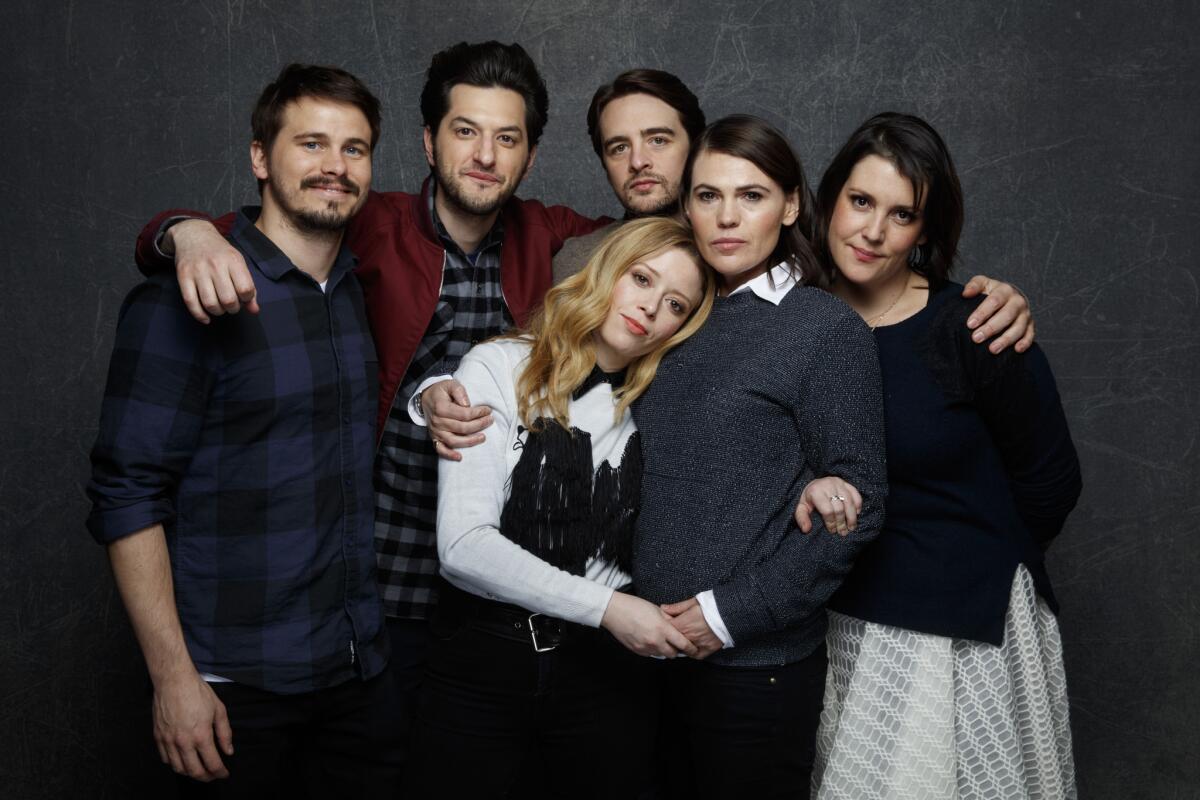
A contemporary take on the reunion in a big house movie – “The Big Chill” was explicitly mentioned as a reference – “The Intervention” is the feature debut as writer-director for Clea DuVall. A Sundance mainstay as an actress, she also appears as part of the film’s charming ensemble, alongside Melanie Lynskey, Cobie Smulders, Ben Schwartz, Alia Shawkat, Natasha Lyonne, Jason Ritter and Vincent Piazza.
In introducing the film’s world premiere on Tuesday as part of Sundance’s U.S. Dramatic competition, DuVall said, “I have been to Sundance many times as an actor, but my first job as an actor was at the Sundance filmmakers’ lab when I was 18. It just feels like such a full-circle, big deal huge thing to be here.” As her voice began to tremble and she seemed overwhelmed in a moment of emotion the audience cheered in support. She paused, pointed to herself and smiled as she said, “I told myself I wouldn’t cry.”
The movie features four couples away at a big family house outside Savannah, Ga., for a weekend away. They are a mix of old friends, siblings, spouses and one new outsider, and the secret purpose of the reunion is so that Annie (Lynskey) and Jessie (DuVall) can stage a “marriage intervention” on Ruby (Smulders). What sounded reasonable enough before they got there quickly becomes a complicated and perhaps misguided idea that brings every couple’s issues to surface.
The movie has a breezy tone overall, but DuVall’s greatest accomplishment may be navigating as a director the tricky shifts in tone she has set for herself as a writer. There are turns toward heartfelt, dramatic emotions among the story’s moments of living-room farce, and the cast likewise all handle it with aplomb.
In the Q&A after the film alongside most of the cast, DuVall spoke how she initially wrote the script thinking someone else would direct it.
“The more I reached out to people the more it became apparent, apparent to me, that I was the only person I really wanted to tell the story,” DuVall said. “It really is coming from a place of loving the process of filmmaking and loving being on sets and working with crews and working with actors.
“I just wanted to become a bigger piece of the puzzle,” she added. “The more I do this the less I become interested in just my part. I want to be a part of all of it.”
Sara Quin of the music group Tegan & Sara was onstage after the film as composer of the film’s music and her sister and bandmate Tegan Quin asked her a question from the audience. “Great film, big fan,” began Tegan, to which Sara responded, “Tegan, hello, big fan.”
DuVall, Lynskey and Lyonne were all together in the 1999 film “But I’m a Cheerleader,” and DuVall noted they have remained friends. As someone asked a question regarding how their off-screen friendship was reflected in the film, DuVall tried to hand a microphone to Lynskey, who repeatedly handed it back.
“The director is trying to make me answer a question that is clearly for her,” Lynskey eventually said.
Lyonne jumped in to say, “I don’t really remember a ton of workshopping this movie, but I do remember, like, 1998 in your little house in Topanga and I remember we were like, ‘Hey, how come actors can’t spend more time like the way musicians can go in the other room and jam?’ So we decided to do dramatic readings from Anne Heche’s ‘Call Me Crazy.’ And I feel like that was essentially workshopping to where we are now. A great book.”
“Something like this we wanted to keep fresh, we didn’t want it to feel rehearsed and wanted to keep it really organic,” DuVall added. “We have so much history together, rerouting it into another story that still pulled from that intimacy and that closeness.”
DuVall was also asked whether she had ever participated in an intervention.
“I did, yeah,” she said with a deadpan pause. “It was unsuccessful.”
- Share via
Time out for studio silliness
There is a lot of pressure at the Sundance Film Festival for films to perform well as they hope to get picked up for broader distribution or just look to make a mark on the festival circuit.
So it’s good to have a release valve in the form of the L.A. Times’ photo and video studio.


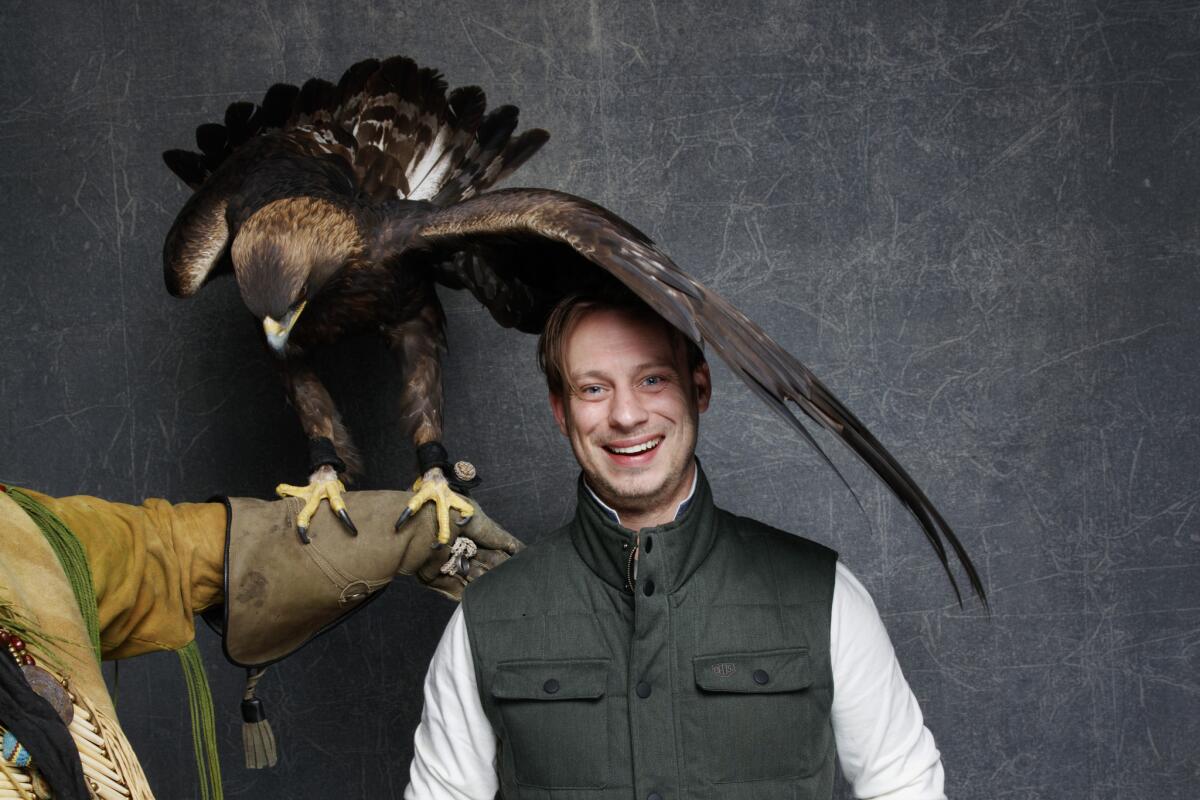
- Share via
HBO’s ‘Jim: The James Foley Story’ -- one to watch
Directed by Brian Oakes, “Jim: The James Foley Story,” tells the tale of American journalist James Foley, examining his kidnapping and brutal killing by Islamic State militants in 2014.
- Share via
Why Lena Dunham’s sister wanted to be in ‘Suited’

Lena Dunham discusses “Suited” with the Los Angeles Times while at the 2016 Sundance Film Festival in Utah.
Lena Dunham explains how her sister, Grace, came to appear in the documentary “Suited.”

- Share via
Chris Rock’s ‘The Birth of a Nation’?
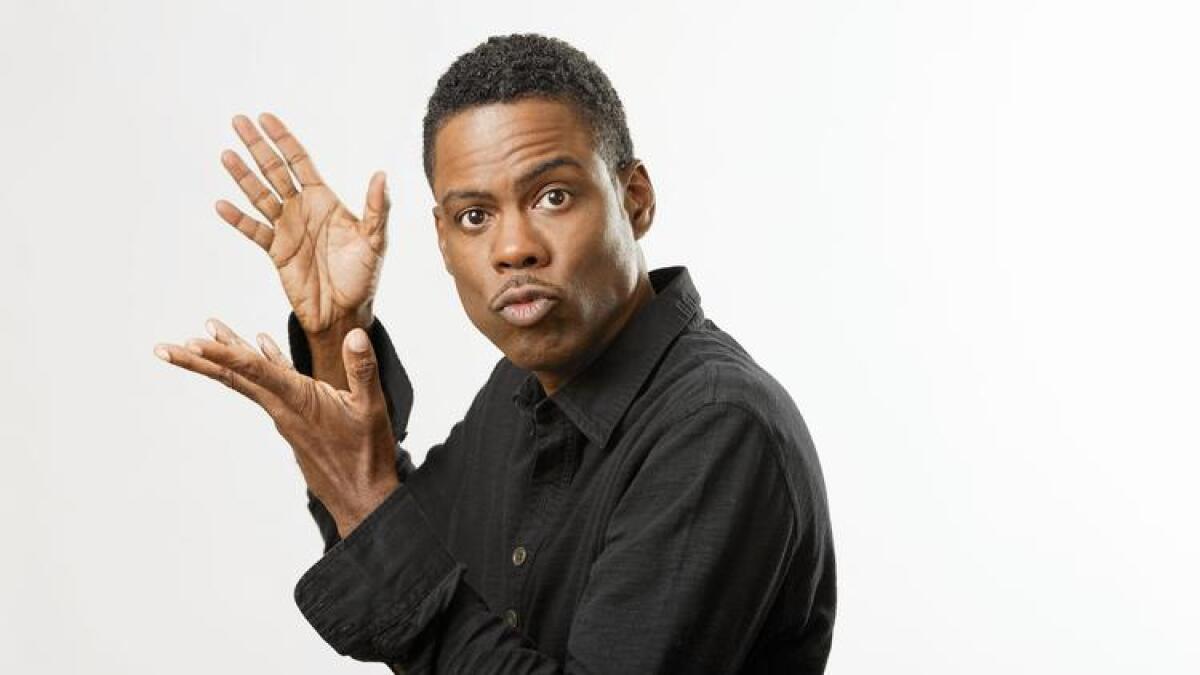
Nate Parker’s Nat Turner biopic “Birth of a Nation” is the talk of Sundance this year, inspiring standing ovations and a massive bidding war.
But Parker isn’t the only filmmaker who has wanted to bring Turner’s story to the big screen.
After directing the comedy “Top Five,” Chris Rock revealed his interest in a Turner project in a November 2014 interview with Los Angeles Times reporter Josh Rottenberg.
- Share via
Critics react to ‘Certain Women’
- Share via
Elisabeth Moss, Boyd Holbrook and Octavia Spencer find ‘The Free World’
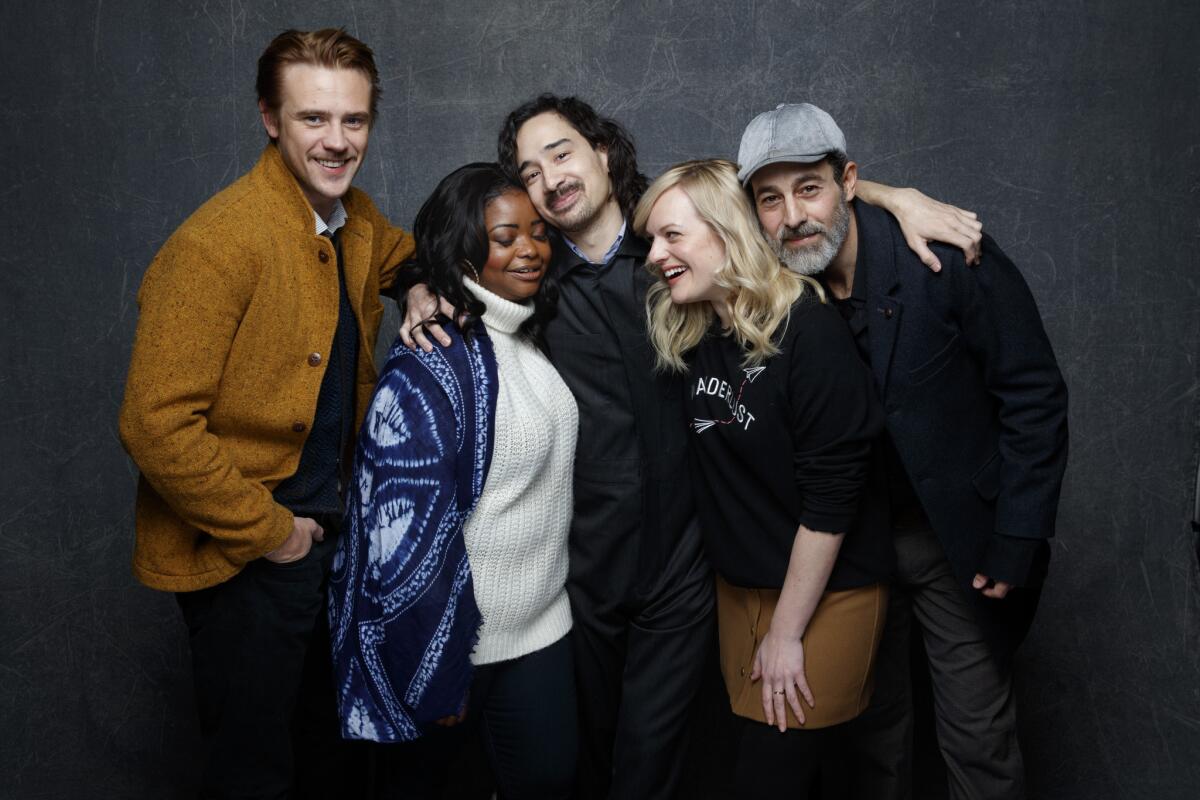
Having its world premiere on Tuesday as part of the U.S. Dramatic competition at Sundance, “The Free World” is the feature debut as writer-director for actor-turned-screenwriter-turned-filmmaker Jason Lew.
In the film, Boyd Holbrook plays Mo Lundy, a man recently released from prison after being exonerated for a crime he did not commit. As he tries to move on with his life, it seems no one wants to let him forget his past. Elisabeth Moss plays Doris, a woman trying to find a way out of an abusive relationship. When the two meet, they instantly see each other in ways no one else does. The film features Octavia Spencer, Sung Kang and Waleed Zuaiter in supporting roles.
Lew’s first screenplay was the 2011 Gus Van Sant romantic drama “Restless.” After that, Lew struggled to figure out what to do next.
“I didn’t have a steamer trunk full of scripts, like here’s my zombie western, here’s my buddy cop movie,” Lew, who lives in Los Angeles, said from Park City, Utah, earlier this week. “So I just did what I did on ‘Restless’: lean into my obsessions, start with characters I find fascinating and see what they have to say to each other.”
What Mo and Doris often have to say to each other is not much, as Holbrook and Moss hold the screen with long silent exchanges. Holbrook turns in a performance that is equal parts physical brawn and interior torment. As with her performance in last year’s “Queen of Earth,” Moss demonstrates a tremendous ability to convey the internal life of a character, conjuring worlds from inside herself.
A section of the film is mostly Holbrook and Moss alone in a sparse apartment, two broken souls each recognizing and respecting what the other has been through.
“I actually like not having a lot of dialogue, although I’ve been very privileged to have some of the best dialogue,” said Moss, in reference to her role on TV’s “Mad Men.” “I love that sort of harking back to the silent-film era when you try to convey emotion without words. For me I find that really challenging and really like it. It feels true to life. I feel like so often we’re not very good at verbalizing how we feel.”
Lew was actually able to drop some dialogue exchanges because everything the characters would have said was already being put across by the actors.
“What was so beautiful was there was a shared language of trauma that they developed between them in looks and stutters and unfinished gestures,” Lew said. It actually was very liberating as a writer to realize, ‘Oh, I don’t need that.’”
In one of the film’s boldest, most tense scenes, Doris climbs into a dog crate to hide when two police officers come to Mo’s apartment. It’s a pivotal moment, as they are both in danger and help each through.
“I looked at it and thought, ‘I can fit in that,’” Moss said of the dog crate. “It’s not that big and definitely smaller than you think it’s going to be and getting into one and then turning oneself around is actually kind of difficult. And I’m not particularly claustrophobic, but when you’re in a crate and someone locks it, it doesn’t feel awesome.”
If climbing into a dog crate isn’t the way many people would want to spend their summer, Moss remained upbeat about all of it, saying “I got some crazy, amazing bruises on this shoot that I was really proud of.”
The film takes a turn toward something of a lovers-on-the-run story, but its emotional center remains in the simplicity of a shared understanding.
“Why I got into the movies is I hope to just recognize myself onscreen in a moment that makes me think, maybe the human experience isn’t an isolated one,” Lew said. “When I felt scared and didn’t think anybody felt that way, ‘Oh, maybe someone else feels that way.’ These are the moments I go to the movies for, and we talked about these being moments of recognition in a very unfamiliar story.”
- Share via
Fox Searchlight makes big buy for ‘The Birth of a Nation’; next year’s Oscars may not be so white
Huge late-night bidding wars are a staple of Sundance. The debate over diversity has taken center stage in Hollywood.
On Monday night, the two converged.
Some of the most intense buyer jockeying in recent memory went down overnight at the festival as “The Birth of a Nation,” Nate Parker’s buzzed-about film about the Nat Turner slave rebellion, culminated in Fox Searchlight buying world rights for an estimated $17.5 million.
The specialty division outmaneuvered a number of other players including the Weinstein Co. and Netflix, the latter of which the filmmakers passed on despite reports of the company’s willingness to pay as much as $20 million.
Parker’s film will now get a major Oscar push and a presumptive fall release as it seeks to replicate the rapture of audiences at Sundance and enter the discussion over race in the culture at large.
The purchase almost certainly means that a depressing Oscar-season conversation is less likely to happen next year, at least in the same way. The Academy of Motion Picture Arts and Sciences has announced membership changes that may or may not have an effect on voting patterns.
But with “Birth” likely receiving a lot of awards attention, the 2017 Oscars field now has at least one strong contender to ensure it’s not so white.
Searchlight has made some big purchases at Sundance over the years, most recently and notably as the central player in the deal to pick up 2015 buzz title “Me and Earl and the Dying Girl” for $12 million. But the company reference point that comes to mind most with “Birth” is, of course, “12 Years A Slave,” a movie Searchlight made with Steve McQueen and unveiled to great acclaim at the fall film festivals, before leading it to the Oscar best picture podium and $57 million in domestic box office. (The film took in nearly $190 million worldwide.)
Whether Searchlight can devise a playbook that imitates that success has suddenly become one of the big film questions of the year. The subject matter, setting and huge festival reaction that “12 Years” and “Birth” share could portend big things for the film, though it’s also worth noting some distinctions, including a lesser-known cast here and, given the Nat Turner story, a different tone. While “12 Years a Slave” ends with liberation. “Birth” culminates in insurrection, and how that resonates among both black and white audiences will be a cultural indicator as the movie rolls out.
“12 Years” was a singular event — at the time. With an intense discussion now taking place about the lack of award-season movies with black casts -- and a studio that knows how to overcome that challenge -- “Birth” will aim to forge its own path through history.
- Share via
‘Wiener-Dog’ director ties ‘Welcome to the Dollhouse’ into new film
Director Todd Solondz talks about filming “Wiener-Dog,” its connections to “Welcome to the Dollhouse” and what he learned from his childhood pets.

Todd Solondz directed the Sundance film “Wiener-Dog.”
- Share via
Sundance stars stop by the #LATphotostudio
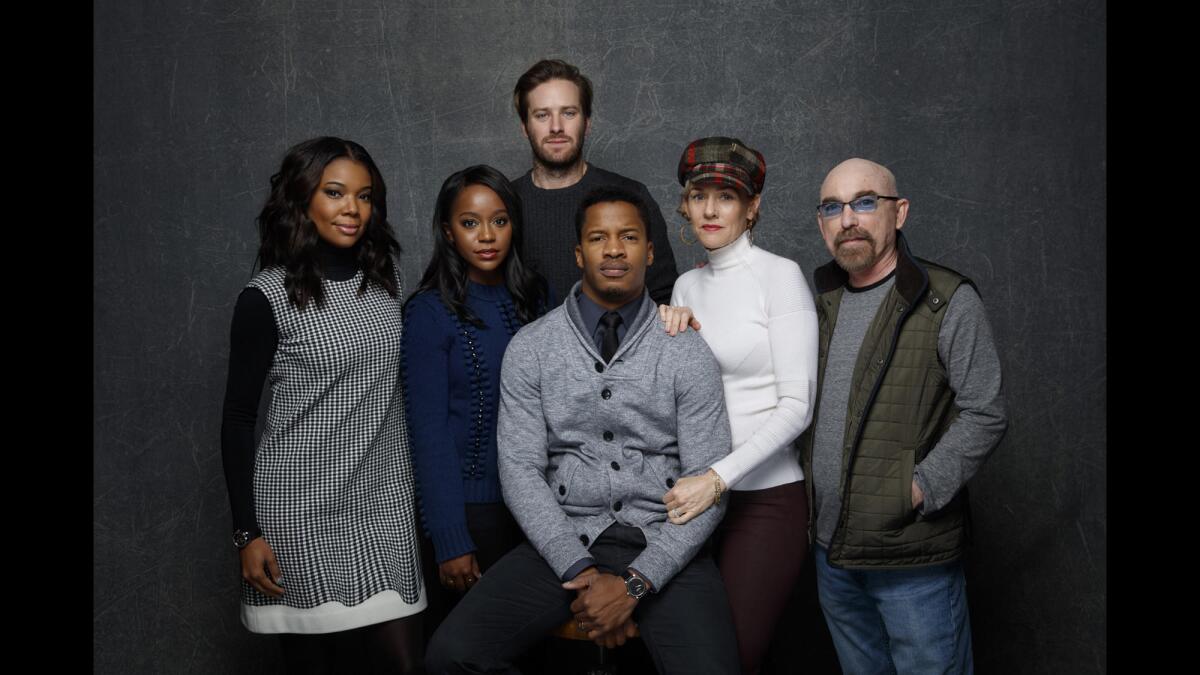
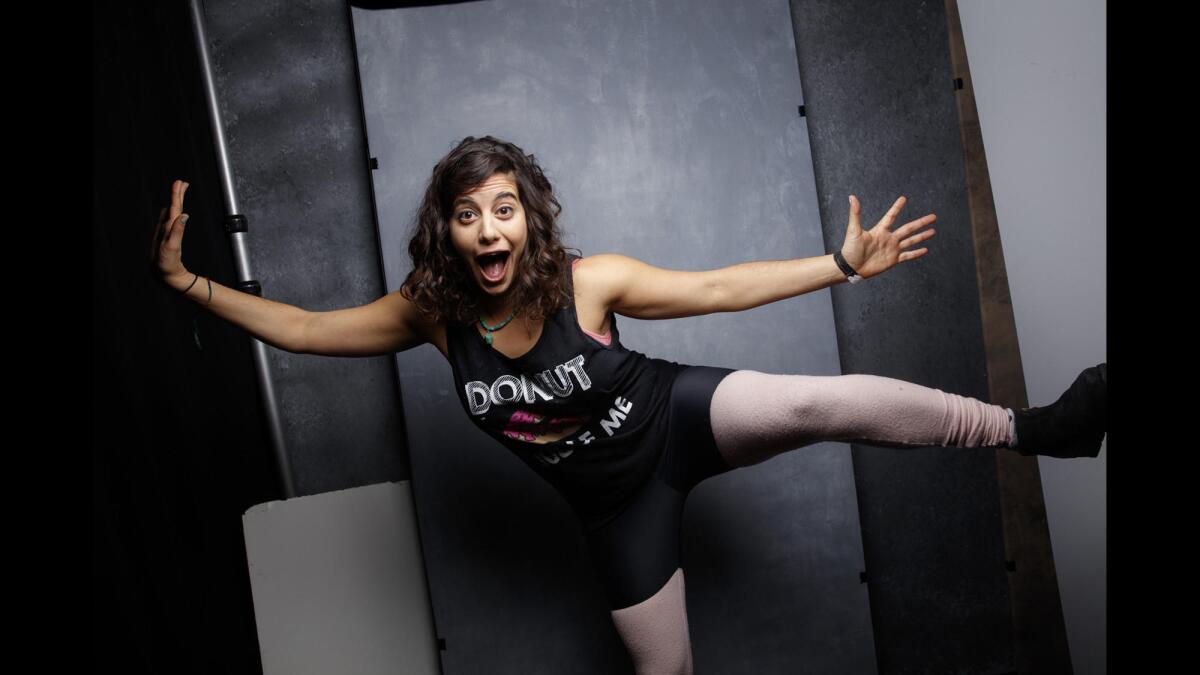
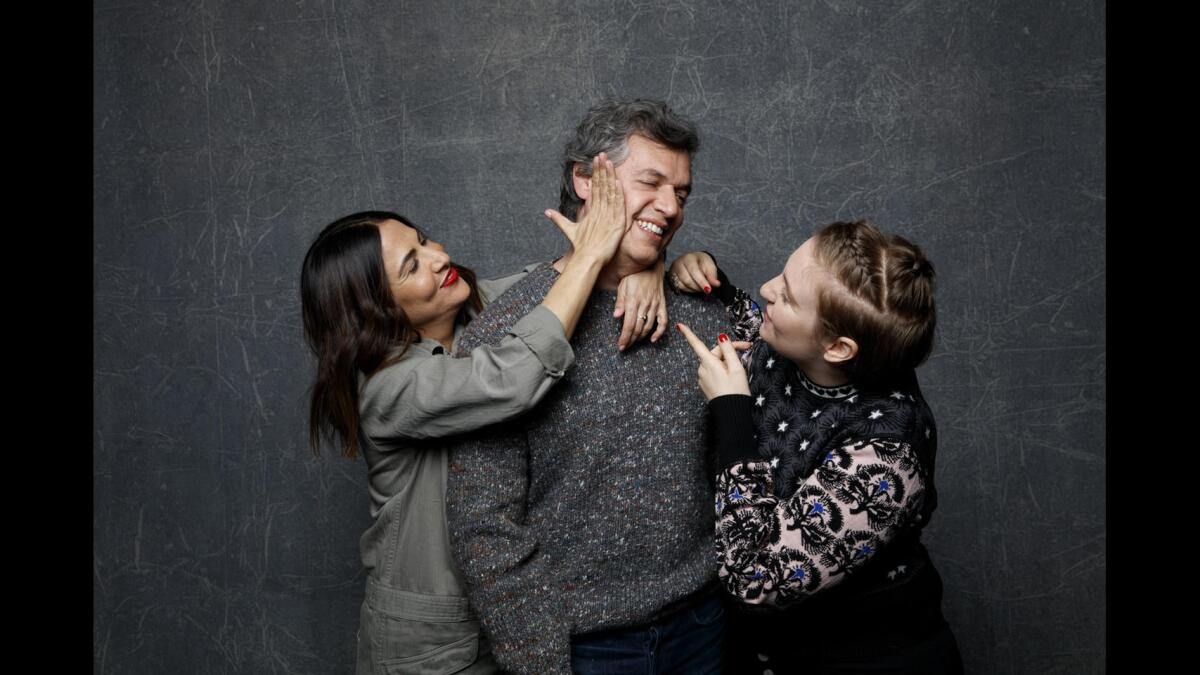
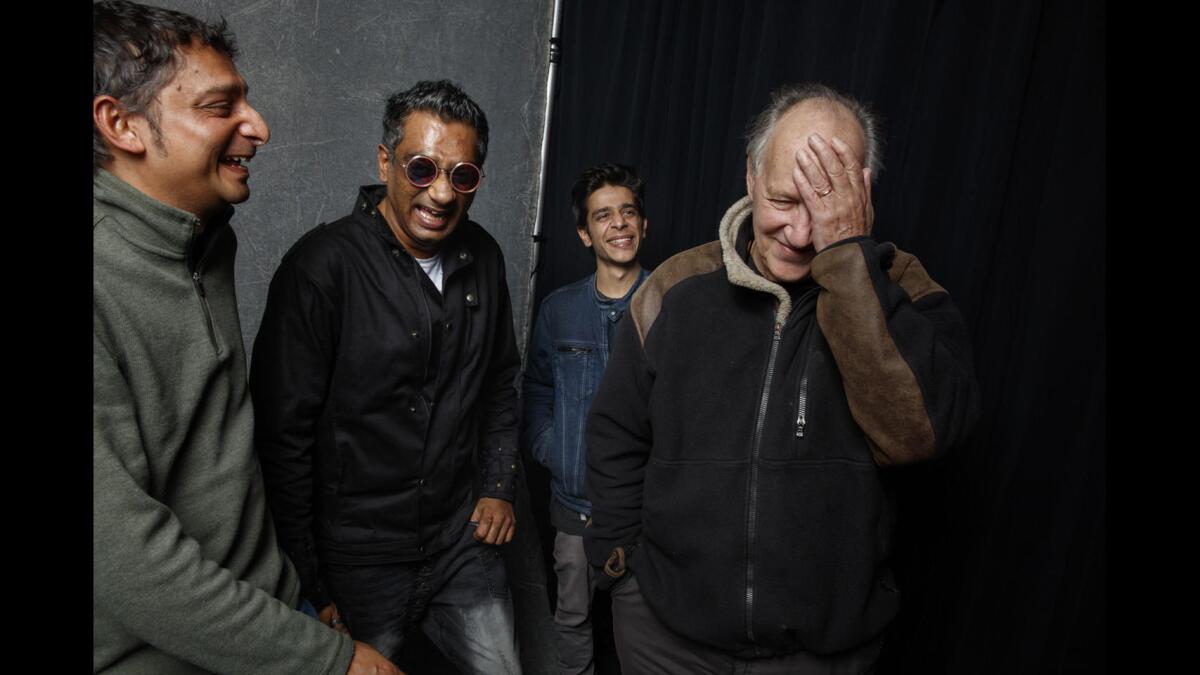
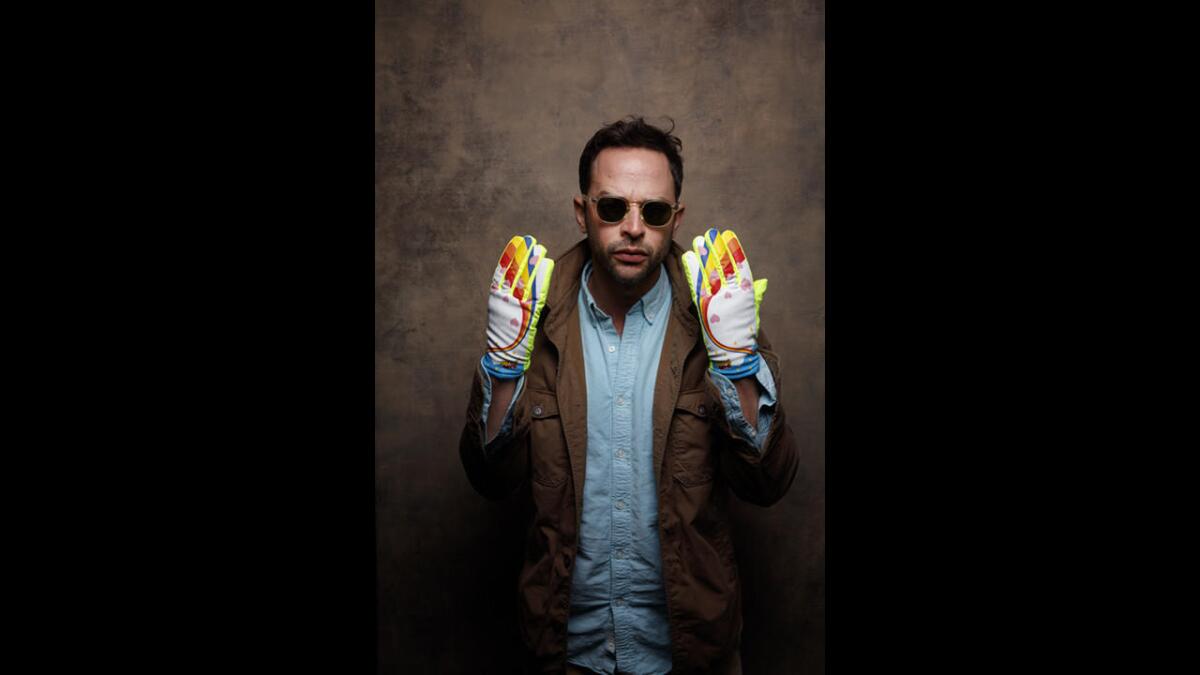
- Share via
What happens when we capture Don Cheadle, Nick Jonas and Riley Keough in Polaroid-style portraits? See for yourself
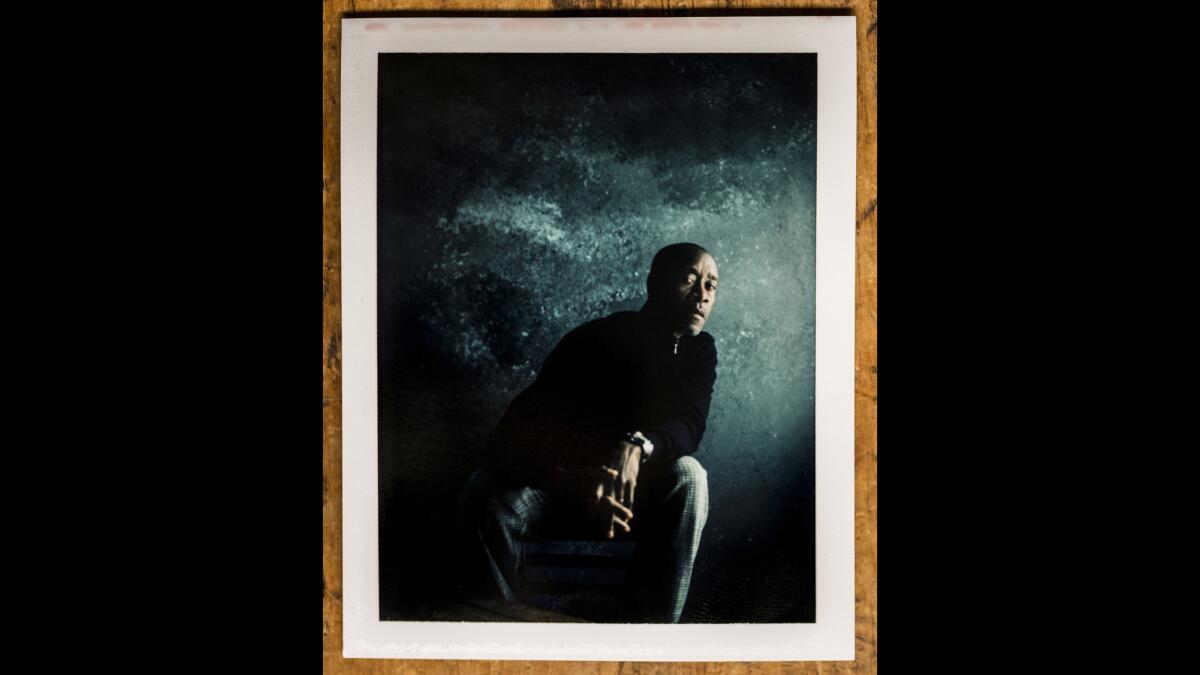
Never mind the chilly corners of Sundance. See how this set of actors and directors warmed up to our photographer, Jay L. Clendenin, during our photo studio session.
- Share via
Breakout film: Nate Parker’s ‘The Birth of a Nation’ injects itself into diversity debate
Usually when we see films about slavery it paints the oppressor as a sociopath so people can check out and say ‘that not like me.’ The reality is there are people in their benevolence who thought they were doing good even though they were doing bad. And in 2016 I think that echoes.
— “Birth of a Nation” director Nate Parker
There’s good timing. There’s great timing. Then there’s “The Birth of a Nation” at Sundance.
Nate Parker’s dramatization of Nat Turner’s 1831 slave rebellion premiered Monday afternoon at the festival to a rapturous response--there was a standing ovation before the movie even began--and continued to spill out after the screening and into the afterparty.
And for good reason. The film arrives in the heat of multiple discussions about race in America, capped in Hollywood by the percolating #OscarsSoWhite movement.
The result of seven years of sweat by Parker (who also wrote, stars and serves as a producer), “Nation” is inspired by a true story that saw a small group of slaves, starting out with rudimentary weapons, eventually take on white slaveowners and their families, killing about 60 of them.
Much of the film has a quiet, almost contemplative vibe, as Turner and his wife Cherry (Aja Naomi King ) endure an ever-so-slightly better life than their fellow slaves, with the former a preacher for the seemingly more understanding slaveowner Samuel Turner (Armie Hammer). As treatment of Nat deteriorates and revolution foments, the movie begins to take on a sharper edge, building to the bloody conclusion.
Indeed, the film’s final chapter offers a violent frankness that could push buttons, infused, as it is, with a spirit of revenge. But just as there will be those who frame it as an angry riposte to black injustice, the movie could also be viewed as a rhetorical attempt to jolt viewers into debate--it is titled “The Birth of a Nation,” after all.
“I made this film for one reason: with the hope of creating change agents,” the filmmaker said as he took the stage after the screening with dozens of the cast and crew. “There were systems in place that were corrupt and corrupted people...and the legacy of that still lives with us,” he added. He added that he offered the movie as a corrective to the “desperately sanitized” tales of the antebellum south.
Speaking with a force of conviction, Parker said the lessons apply even to those ostensibly fighting for the 21st-century cause of equality.
“Usually when we see films about slavery it paints the oppressor as a sociopath so people can check out and say ‘that not like me,’” Parker said pointedly, refering to Hammer’s character. “The reality is there are people in their benevolence who thought they were doing good even though they were doing bad. And in 2016 I think that echoes.”
Parts of “Birth” may evoke comparisons to “12 Years a Slave” and “Django Unchained,” even though Parker began working on this film long before either of those movies reached the screen. In any event, where “Django” is clearly situated in the world of revenge fantasy, this aim for something far more dramatic and historical.
How the movie, which is seeking distribution at Sundance, will play in the wider world remains to be seen. But if the crowd Monday—which featured some the most diverse audience members at the festival--is any indication, whoever buys the movie will have little to fear.
Before each screening at Sundance, a festival rep introduces the filmmaker -- typically a pro forma matter. But when John Cooper, the festival’s director, brought Nate Parker onto the stage, the crowd rose to their feet to give the 36-year-old a round of applause. That standing ovation resumed the instant the film concluded, with filmgoers getting out of their seats to cheer through the credits until Parker returned on stage for a Q&A session.
Each audience member who asked a question seemed deeply moved, beginning with the first woman who raised her hand to ask: “This film carries a lot of responsibility; how can we help you carry it?”
Commentators were enthused too; Variety’s Ramin Setoodeh wrote that “Although next year’s Oscars are still 13 months away, it’s hard to imagine a scenario where Parker isn’t a strong contender for best actor.”
As the crowd exited the Eccles, audiences members were handed a beanie that touted the promotional hashtag: #NatTurnerIsComing. Some filmgoers sported the caps at the after party, where the mood was celebratory and even had a sense of gravitas, as both white and black Hollywood insiders evinced a feeling they’d completed a mission.
Parker had solid acting career for years. He was last seen in “Beyond the Lights,” the 2014 romantic drama in which he played a police officer who heroically convinces a pop star not to commit suicide. He’s also had roles in the Liam Neeson action thriller “Non-Stop” and the ensemble drama “The Great Debaters.”
But he decided to leave acting behind to pursue “Birth.” The movie nearly fell apart several months before production as nervous investors pulled their money, and many cited tropes about black stars overseas. But Parker stayed with it, working financiers around the country to raise the final funds for the budget, which is in the $8-$10 million range.
Asked at the screening why he remained undeterred, Parker offered a quote from George Lucas, in whose “Red Tails” he starred. “When everybody is telling you something can’t be done,” the director said, “that’s when you know you’re on the right track.”
— Steven Zeitchik and Amy Kaufman
- Share via
New Spike Lee film on Michael Jackson is all about the music
Michael Jackson’s life was colored by talent, toil and tragedy.
Spike Lee’s new documentary about the late singer doesn’t deal with the tragic and troubling aspects of his life, including allegations of child molestation and drug abuse, but instead focuses on his transition from a member of the Jackson Five to his solo career -- and the work Jackson put in to make it happen.
The film, “Michael Jackson’s Journey from Motown to Off the Wall,” reminds us that superstardom wasn’t a given. By 1975, when the Jackson Five’s Motown contract expired, many in the record business figured the brothers were done. They ended up signing a new contract with Epic/CBS Records as The Jacksons, a deal that also laid the foundation for Michael’s solo career.
The centerpiece of the documentary, which premiered at the Sundance Film Festival this week, is the story of Jackson’s 1979 breakout album “Off the Wall.”
The documentary features interviews with Quincy Jones, Mark Ronson, John Legend and others who break down the technical feats behind the album’s astonishing success -- including four top 10 singles and the No. 1 hit “Don’t Stop ‘Til You Get Enough.” Lee also interviews a few people outside the music business who speak to Jackson’s work ethic, including Kobe Bryant.
Lee contends that “Off the Wall” is more important than its more famous followup, “Thriller” (the best-selling album of all time), because it established Michael as a superstar in his own right.
The film, which debuts on Showtime on Feb. 5, drew an enthusiastic response from the crowd that packed the MARC Theatre at Sundance. The film also includes rarely seen clips from the Jacksons’ four-night stand at the Forum in Inglewood as part of the group’s Triumph Tour, showcasing the raw electricity and polish of Michael Jackson as a performer.
“It’s the work he did,” Lee said in an interview with the Los Angeles Times when asked to explain the enduring legacy of Jackson’s music. “People are listening to his music, not because of the Grammys he won, it’s the work. The work. That’s what gonna last.”
At a panel discussion after the film, Questlove (Ahmir Khalib Thompson) of the Roots said the film is a means to bring Jackson’s music to younger listeners.
“People automatically think this stuff will translate to the next generation,” he said, adding that he teaches music classes at New York University and students are “really not familiar” with Jackson’s legacy.
“We now have the tools. We have Spotify,” Questlove said. “Make your kids a playlist. Just don’t assume that brilliant stuff on its own will automatically reveal itself to the next generation.”
Lee, who previously did a film called “Bad25,” which was tied to the 25th anniversary of Jackson’s “Bad” album, was asked if a deep look at “Thriller” is next.
“If that happens, I’m good,” he replied. “Trilogy.”
- Share via
Sundance reacts to ‘powerful’ ‘Birth of a Nation’
Nate Parker’s highly anticipated Nat Turner biopic has premiered at Sundance to wide acclaim. Among the reports of multiple standing ovations, critics and writers are using such superlatives as “powerful,” “epic” and “tour de force” to describe the film, which stars Parker, Gabrielle Union and Armie Hammer.
— Dave Lewis
- Share via
‘Los Punks’ film premieres at Slamdance Film Festival
Director Angela Boatwright talks about her new documentary, “Los Punks,” at the Slamdance Film Festival. The film documents the backyard punk rock scene in East Los Angeles, South Los Angeles and other communities far from the West Hollywood club scene. She’s joined by several young people who are part of the L.A. punk rock scene. Slamdance is held alongside the Sundance Film Festival.
- Share via
Smile, Sundance!
See who stopped by The Times’ Sundance photo studio. All photos by The Times photographer Jay L. Clendenin.
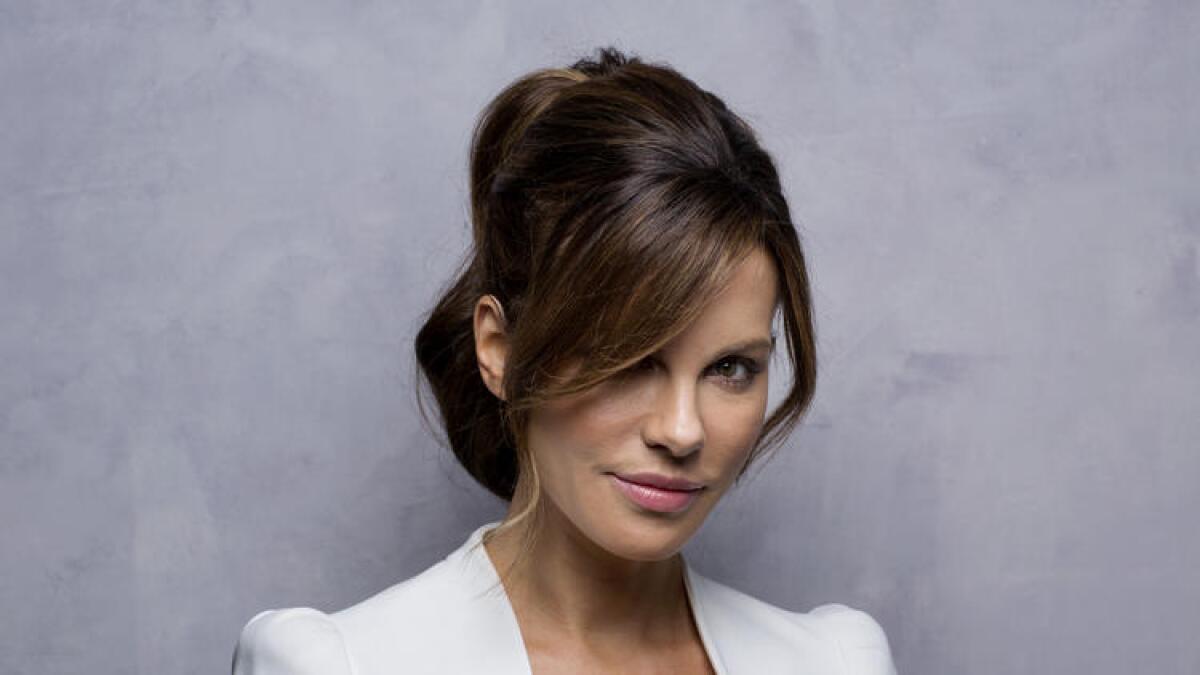
- Share via
‘Author: The JT Leroy Story’ turns a forgotten controversy into a thrilling exploration
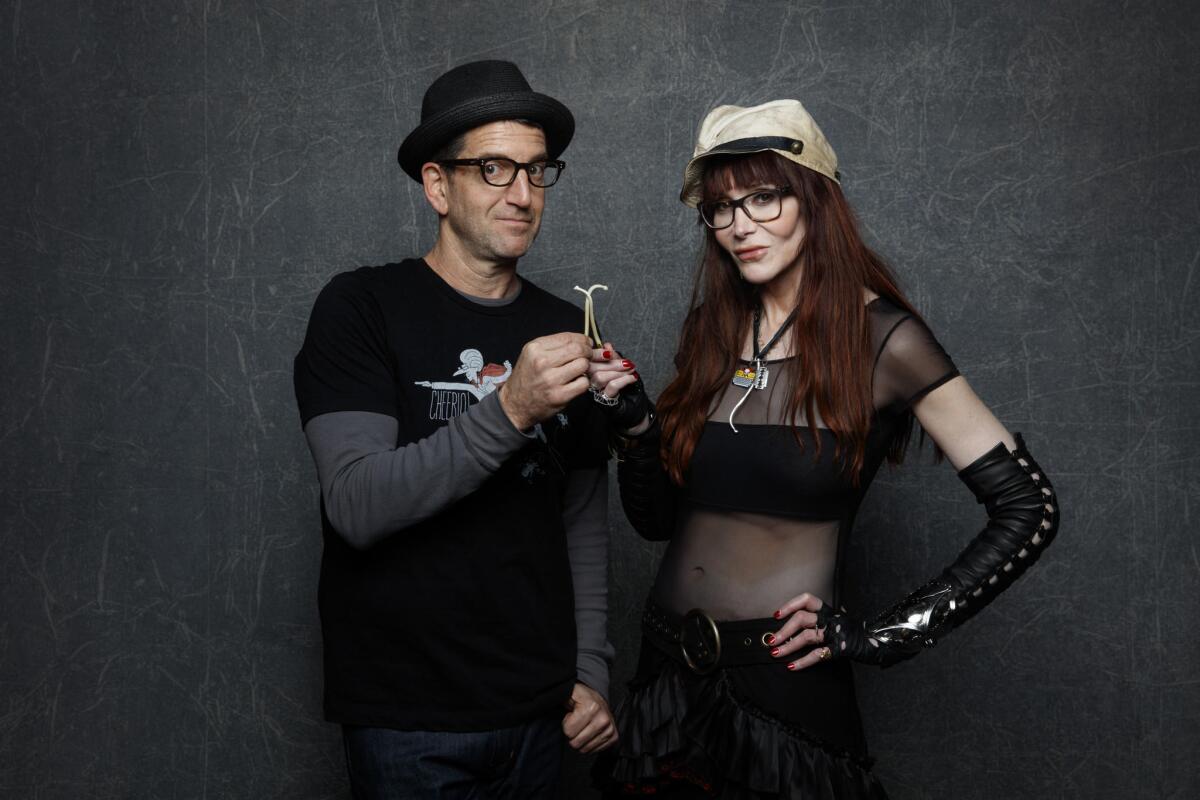
For many people, the JT Leroy scandal of a decade ago was a passing headline, a story that had lasting resonance to a few publishing insiders at best.
But as the indie-film director Jeff Feuerzeig discovered, the Leroy affair was much more than we know -- a strange, existential and ultimately thrilling story of a woman donning identities with a degree of spy-novel ambition (and, sometimes, Mel Brooks absurdity).
Feuerzeig is the director of “Author: The JT Leroy Story,” a new documentary about the nearly decade-long invention pulled off by the writer Laura Albert. The movie premiered at the Sundance Film Festival this weekend ahead of playing on A&E and likely in theaters later this year. With vast access to Albert’s copious archives and thoughtful on-camera remembrances, Feuerzeig constructs a tightly woven and almost unbelievable yarn.
“If I didn’t live through making the movie, I don’t know if I would have believed what happened,” Feuerzeig said in an interview at a condo here shortly after the film premiered this weekend.
- Share via
Werner Herzog talks technology, ski jumping and Honey Boo Boo
“Lo and Behold: Reveries of the Connected World” director Werner Herzog urges people to scrutinize their environment and asks, does the Internet dream of itself?

Steve Zeitchik chats with director Werner Herzog about his documentary, “Lo and Behold: Reveries of the Connected World,” Honey Boo Boo and ski jumping.
- Share via
Amazon lands Sundance buzzmaker ‘Manchester by the Sea,’ among others

A year after Amazon Studios announced its plans to join the fray of producing and distributing movies, the Seattle-based company is opening its wallet in a big way at this year’s Sundance Film Festival.
In a big coupe over the weekend, Amazon won the bidding war for the domestic streaming rights to “Manchester by the Sea.” The film, directed by Kenneth Lonegran and starring Casey Affleck as a guy who is asked to take custody of his nephew when his brother (Kyle Chandler) dies, has been the talk of Park City. Times’ critic Kenneth Turan described it as “powerful, emotional filmmaking that leaves a scar.”
- Share via
‘Silicon Valley’ star compares comedic and dramatic acting
Thomas Middleditch of HBO’s “Silicon Valley” says comedy may be hard, but drama...
- Share via
Sundance breakout stars: Ben Schnetzer in ‘Goat’
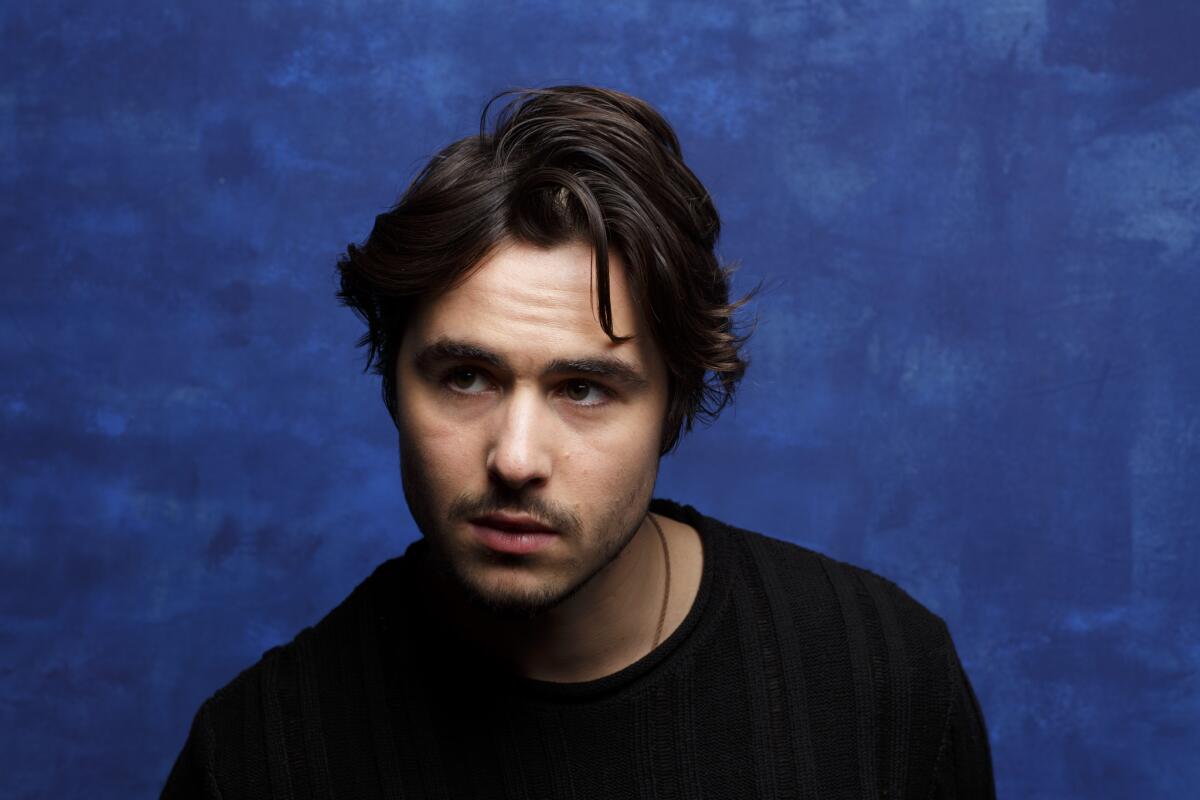
Name: Ben Schnetzer
Age: 25
Hometown: New York, New York
Where you’ve seen him: “Pride,” “The Book Thief”
Sundance film: “Goat,” Andrew Neel’s drama about young male pledges who face brutal hazing while rushing a college fraternity.
Why you should remember his name: He gives the standout performance in “Goat,” the tale of two brothers whose relationship becomes strained once they join the same frat. Schnetzer plays the younger of the two brothers opposite Nick Jonas, a frat veteran who is troubled by seeing his sibling subjected to various forms of public humiliation.
How he got the part: He auditioned -- though his resemblance to Jonas didn’t hurt. “In high school, there was this girl who would always make fun of me like, ‘Oh, hey, Joe Jonas!’” he recalls. “There’s worse people to look like, but I do remember being teased.”
Family: His parents, Stephen Schnetzer and Nancy Snyder, are also actors and met on the set of “One Life to Live.” His older brother, Max, is a farmer.
Training: He spent nearly three years studying at Guildhall School of Music and Drama in London, where he moved to be with a girl he was dating.
How he prepared for Sundance: First, he freaked out. “It feels like a rite of passage to be here,” he says mid-fest. “I’ve always seen the portraits taken here, and that laurel leaf on a movie title saying something was a Sundance selection.” Once he got past the excitement, he started thinking about how he’d handle difficult questions the film raises about frat culture. “I knew I’d be asked things that I wanted to format diplomatic responses to,” he says, “because it’s a provocative film. There were times you could hear a lot of uncomfortable laughter or see people looking away. And that’s exciting.”
What he learned from “Goat”: To stand up for yourself. “A lot of times I’ll be in situations where I’ll think, ‘Why didn’t I say anything?’” says Schnetzer. “If you’re on the subway and you see a guy giving a girl [crap], it’s like, why didn’t I man up and say something? Or in the industry, there are often times where you’re not treated that nicely and you think, ‘Why didn’t i stand up for myself?’ It’s one thing to have a thick skin, but it’s another to be able to advocate for yourself.”
How the film changed his view on masculinity: Growing up in New York, Schnetzer says, he “never felt pressure to be a macho, bro-ish” guy -- he was surrounded by artists who were generally pretty accepting. But working on Neel’s film did cause the actor to start thinking about how he defined manhood, and how masculinity is viewed within Hollywood. “I think certain performances really color trends,” he says of the leading man ideal. “After Johnny Depp was in the first ‘Pirates of the Caribbean,’ I saw a big shift where the lead often became a caddish, wily guy -- not the clean-cut heartthrob, but the more edgy kind of anti-hero.”
Where you’ll see him next: He has roles in Oliver Stone’s “Snowden” and the film adaptation of the online role-playing game “World of Warcraft,” both of which are slated for release this year. But soon he’ll be off to the Canadian arctic to shoot “Grizzlies,” about a history teacher to moves to an Inuit village to coach lacrosse.
- Share via
‘Manchester by the Sea’ gets rave reviews ... mostly
Powerful, emotional filmmaking that leaves a scar, “Manchester by the Sea” is the kind of experience people trek to Sundance for, Los Angeles Times’ film critic Kenneth Turan says. See if other critics agree.
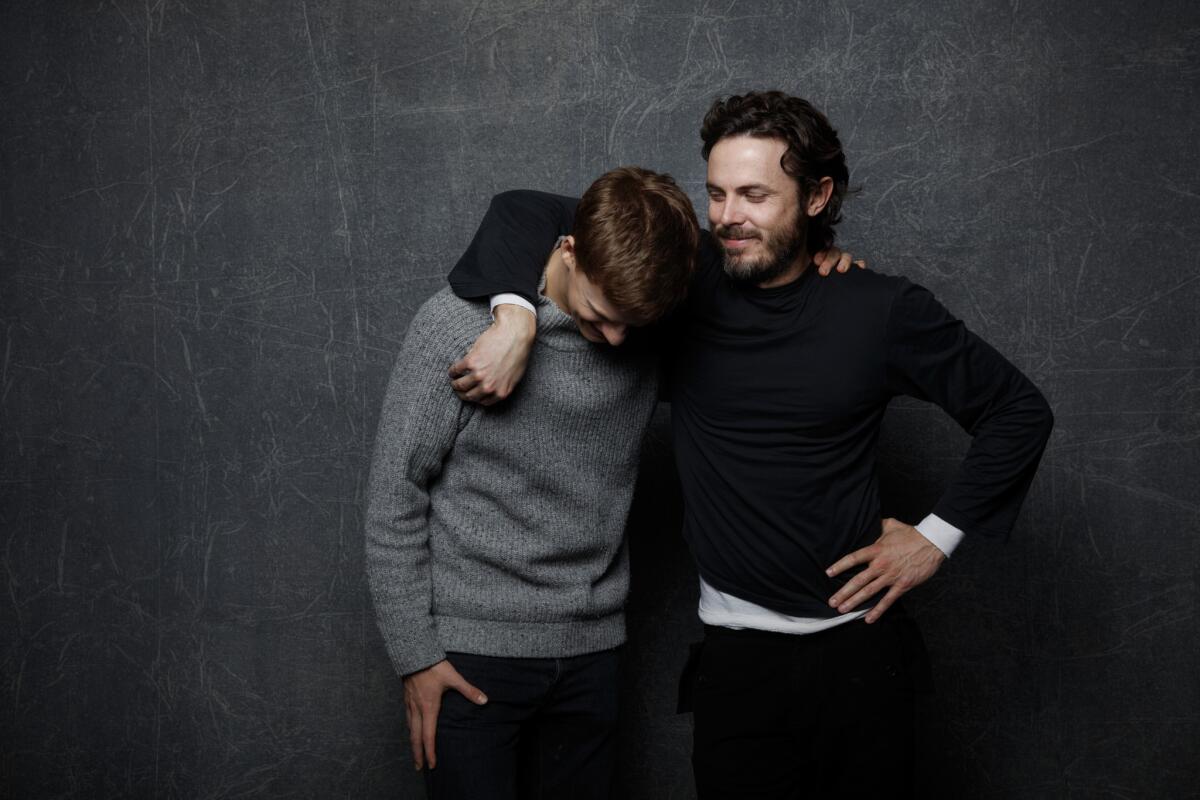
- Share via
Video: ‘Christine’ star Rebecca Hall on ‘lowest common denominator’ acting
Rebecca Hall, who stars in the new film “Christine,” talks about making acting choices during a panel discussion at the Sundance Film Festival. The video is by the Times’ John Corrigan.
Hall portrays Christine Chubbuck, an up-and-coming journalist on a Sarasota, Fla., TV station in 1974 when, at 29 and after an apparent ongoing battle with depression, she took out a gun on the air one night and ended her own life.
Hall’s performance is generally receiving good responses from festival attendees.
- Share via
Directors of ‘Certain Women’ and ‘Indignation’ show their talent to adapt
Kelly Reichardt and James Schamus are stalwarts of the independent world, and both debuted excellent films Sunday at the Sundance Film Festival. And though Schamus is, in his own words, “at the tender age of 57 a first-time director” and Reichardt is a veteran who has been behind the camera for more than 20 years, they have both succeeded at the same daunting task: making first-rate cinema out of outstanding literary work.
Reichardt’s “Certain Women” stars the powerhouse trio of Laura Dern, Kristen Stewart and Michelle Williams, a virtuosic Rene Auberjonois and a radiant Lily Gladstone. It’s turned a trio of astute and emotionally powerful short stories by Maile Meloy into what the director has called “a drama about small life stories,” finely modulated and taking place in Montana.
Schamus, for his part, has taken on “Indignation,” a disturbing novel by Philip Roth set during the Korean War, casting Logan Lerman as college freshman Marcus Messner, the bright son of a Newark, N.J., kosher butcher, who falls in love with the beautiful, WASPy but troubled Olivia Hutton (Sarah Gadon).
“The film itself is about desire, about how in placing it you misplace yourself, you lose your footing,” said Schamus, whose screenplays include “The Ice Storm,” “Lust, Caution” and “Crouching Tiger, Hidden Dragon.” “Everything I adapt has that aspect.”
In talking to both Schamus and Reichardt about the challenges, difficulties and satisfactions of adaptation, it was striking that their experiences were both similar and disparate, that the way they approached material reflected, as might be expected, their personal attitudes and philosophies about the filmmaking process.
- Share via
Video: Jason Benjamin, Lena Dunham and Jenni Konner talk ‘Suited’
Jason Benjamin’s directorial debut, “Suited,” is a documentary about the Brooklyn-based tailoring company Bindle & Keep, which serves the LGBTQ community. The film is produced by Lena Dunham and Jenni Konner. Reporter Amy Kaufman interviews while videographer Myung Chun records it all.

Jason Benjamin’s directorial debut, “Suited,” is a documentary about the Brooklyn-based tailoring company Bindle & Keep, which serves the LGBTQ community. The film is produced by Lena Dunham and Jenni Konner.
- Share via
Anthony Weiner movie ‘Weiner’ throws a light on modern politics -- and Hillary Clinton
The political documentary is a time-honored tradition in independent film, which delights in taking news figures and reexamining them with a long lens.
But it’s rare that a movie about something as roilingly current as “Weiner,” the new documentary about fallen political hero Anthony Weiner that premiered Sunday at Sundance, makes its way to the surface.
Elyse Steinberg’s and Josh Kriegman’s film, which was picked up by Sundance Selects and Showtime before the festival, touches on a figure who was regularly topping the news not 30 months ago -- and whose place at the center of an election-season quick-spin-cycle feels notably current.
Equally relevant, the documentary touches on hot-button questions involving presidential candidate Hillary Clinton, on whose staff Weiner’s wife, Huma Abedin, serves.
Steinberg’s and Kriegman’s film (the latter once worked for Weiner) offers a remarkable window into the onetime congressman and New York mayoral candidate. Back in 2013, you may recall, the Democratic lawmaker seemed to put all his sexting and lewd-photograph troubles behind him and was surging in the mayoral polls when new allegations doomed his campaign.
In the film, Weiner can be seen strategizing with his staff as the political heat mounts, engaging in candid asides with Abedin (she stands by him, ambivalently) and showcasing a bowed-but-not-broken attitude in places such as the back of a campaign car, where some of the movie’s most intimate moments take place.
“We always had known that is an incredible and fascinating character,” Kriegman said at Sundance after the screening.
“We’ve seen countless celebrity meltdowns,” added Steinberg. “This was about being in the room when it happens and the humanity behind it.”
The filmmakers stop short of saying they wanted to draw a sympathetic portrait. But they do say they wanted to humanize their subject -- to show a “multifaceted” person, which they do in spades.
Weiner can be arrogant and charming, swaggery about his views and self-deprecating about his foibles (including, sometimes, the big one). The impression one is left with is of a man whose strength is his weakness: Weiner came to prominence with his feistiness, but that trait is also his downfall, as when he yells back to a heckler at a campaign stop in a bakery in a video that soon went viral.
Weiner has some self-awareness about the consequences of his pathologies, even if it takes public humiliation to get him there. “Yeah,” he says quietly several times when he feels regret about what his actions have done to his family. (The filmmakers are so present -- and, often, asking questions -- that at one point Weiner comically muses to the camera about a fly on the wall, wondering if there’s a species that talks too.)
One wishes more was shown on the political hit-job aspects of the story -- if Weiner did supply the bullets for his murder, there were certainly GOP leaders, turned off by his aggressive style in Congress, happy to fire the gun. And there is little about what that drove him to such frequent phone- and text-based sex in the first place, even at great expense to his career. (Weiner does at one point suggest that politicians are “wired” to need attention, whether of constituents or romantic partners.)
Still, the film offers great insight into the process of an election campaign in the modern media world, whether it’s the optics of sullen campaign strategists or the intersection of tabloidism and politics (reaching its absurd conclusion when Weiner and staff sprint through a McDonald’s to avoid Sydney Leathers, one of Weiner’s phone paramours.)
Kriegman said he initially thought this would be a comeback story -- indeed the film’s first half revels in that angle -- before new revelations took it in a different direction.
“At the beginning of the campaign, no one in the entire world knew what was going to happen,” he said after the screening. “For a while, this was a comeback story ... and then things took a turn.”
And the story is ongoing. Most pertinent is the role of a conflicted Abedin, who as the scandal crests may or may not have been asked by Clinton to distance herself from Weiner in public. Though Abedin is not seen weighing in on this, the implication that she was pressed to choose between her husband and her job hangs heavily over the film, and how much it can be used by Clinton opponents will be one of the key questions as the film rolls out, beginning in May.
In fact, even the absence of a smoking gun is problematic, because it feeds into questions over whether the Clinton campaign asked that such damning material be removed.
At the screening, Steinberg said, “There was no footage taken out because of pressure from Hillary’s campaign, “That’s just not true.” Kriegman said Weiner hadn’t seen the movie but that the filmmakers hoped he one day would; the comment did not directly address reports that the former congressman has asked to see it but was denied that request.
Abedin has already become a controversial figure to Republicans, who have raised questions about whether she improperly accepted money to work as a consultant while serving Clinton in the State Department. The movie, if nothing else, puts her in the spotlight -- shining a beam on a person who, like most strategists, prefers to work outside of public view.
Steinberg and Kriegman said their goal in making the film was to offer a corrective to the late-night-comedy, punch-line culture of modern politics -- Weiner is the example par excellence of this -- though ironically the movie could be used to put Weiner and his indiscretions back in just such a context.
At the end of the film, Weiner shows his flair for wry humor when he turns to the camera and asks, essentially, “Why did I let you film this?” The politician may still be struggling with that question. Informed viewers, however, will be grateful he did.
- Share via
From the #LATphotostudio
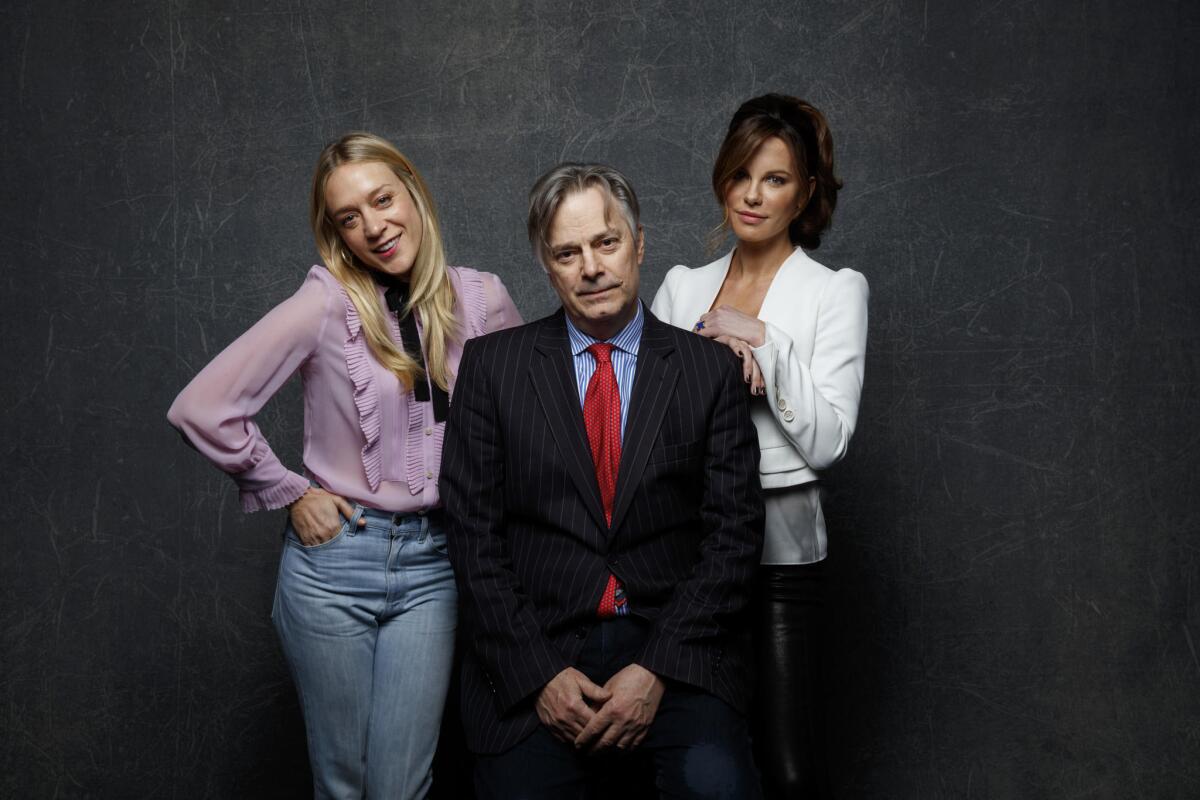
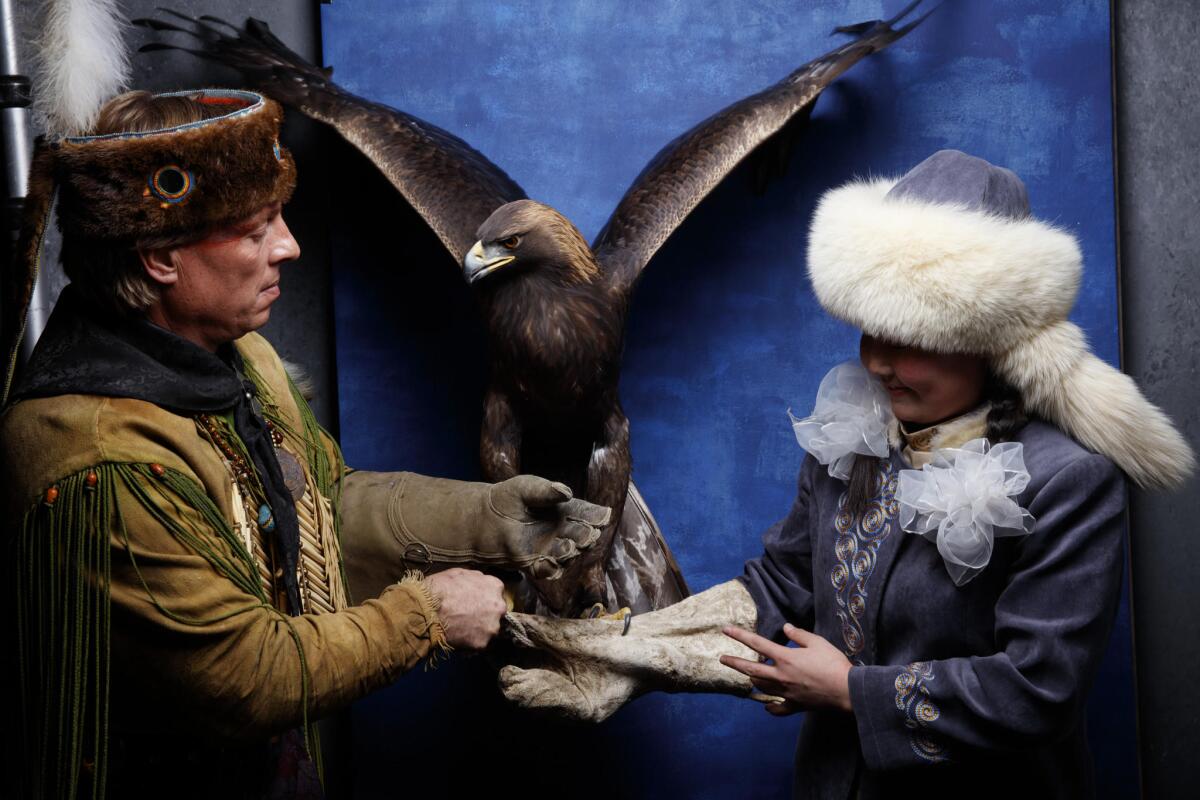
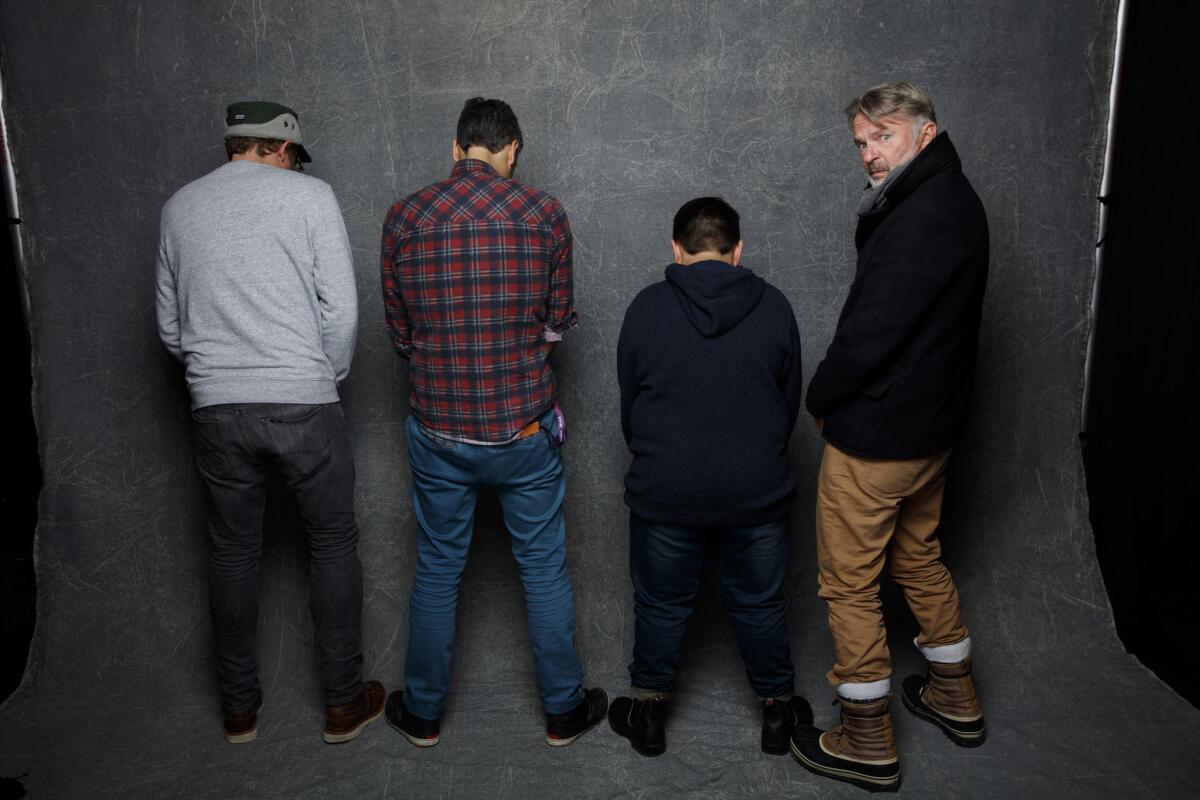
- Share via
From the ‘Weiner’ screening
- Share via
Kenneth Lonergan’s emotional ‘Manchester By the Sea’ is the talk of the fest
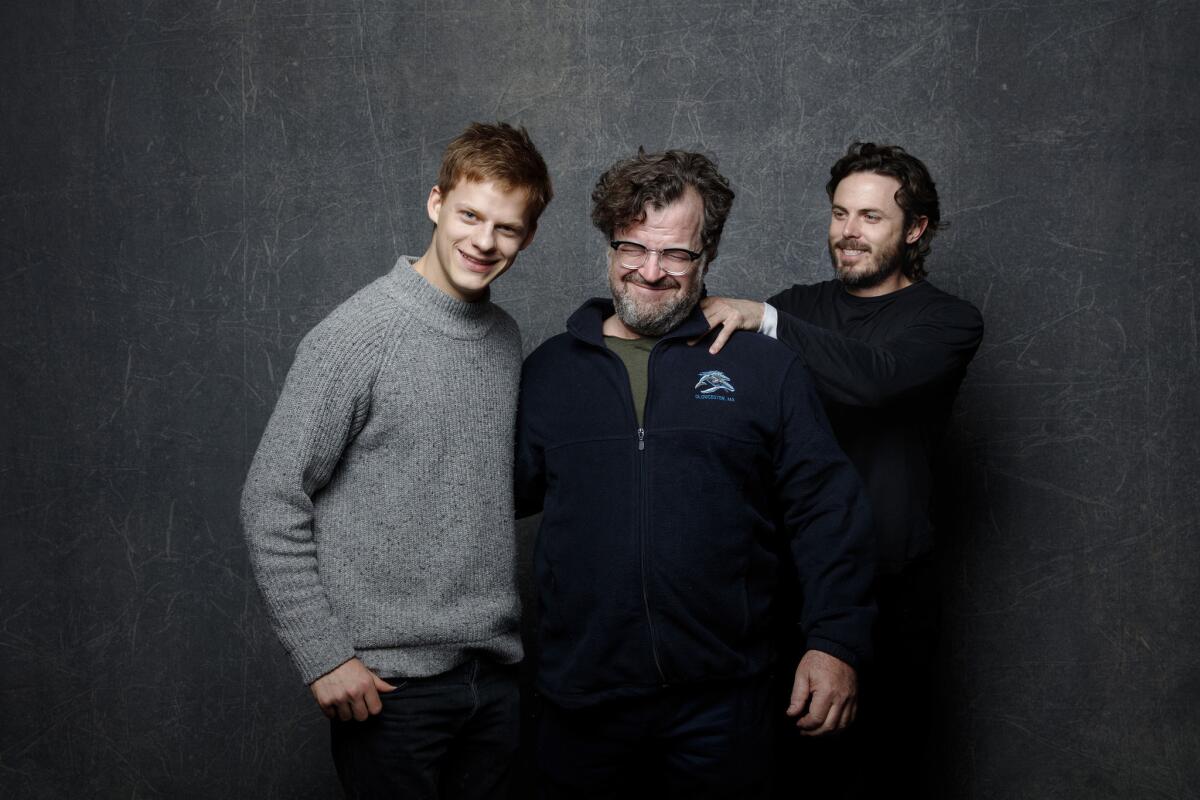
Powerful, emotional filmmaking that leaves a scar, Kenneth Lonergan’s “Manchester By The Sea” is the kind of experience people trek to Sundance for, and the film was received like a conquering hero at its Saturday afternoon Park City debut.
Writer-director Lonergan, who won the Grand Jury Prize here in 2000 with “You Can Count On Me,” opened the post-screening Q&A at the Eccles Theater with a diffident “I think it needs a little work,” but audiences and circling distributors begged to differ.
Producer Matt Damon, who has been with the project since the beginning and was at one point set to play the staring role of Lee Chandler, said he “never made it through any iteration of the script without crying.”
When scheduling conflicts made Damon’s acting in this dicey, “in an atypical fit of generosity, I gave it to Casey Affleck. I didn’t want to get in the way of a great movie being made.”
Affleck beautifully plays Chandler, a handyman in a Boston apartment complex who lives a closed-off, stunted life, a hostile individual who gets into bar fights and watches a lot of TV sports to make the time pass.
Then Lee’s older brother suddenly dies of congestive heart failure and Lee is unexpectedly named the guardian of his equally sullen 16-year-old nephew (a breakout performance by Lucas Hedges).
That assignment, which Lee mightily resists, mandates a return to the family’s hometown of Manchester by the Sea, where Lee has to confront the tragedy, revealed in an intricate series of flashbacks, that turned his life inside out.
“Manchester By The Sea” is finely acted not only by Affleck and Hedges but also Michelle Williams, literally stunning as Lee’s divorced wife. The real star, however, is writer-director Lonergan, who has brought the tang of truth to a world where heartbreak and humor coexist, a world where something real is unfolding under our very eyes.
- Share via
Video: Nick Jonas on playing a hazing frat bro in ‘Goat’

Nick Jonas and Ben Schnetzer star in “Goat,” a film directed by Andrew Neel that takes a hard look at the male culture through the lens of fraternity hazings.
Director Andrew Neel and actors Nick Jonas and Ben Schnetzer discuss “Goat” and the culture of fraternity hazings.
- Share via
Sundance 2016: In ‘Christine,’ Rebecca Hall brings perfect balance to an imbalanced subject
It stands as one of the most shocking live television moments in U.S. journalism history.
The viral video age has given us its share of bizarre, human and tragic stories. But one of the strangest and most haunting on-video moments didn’t happen in the Snapchat era — it occurred more than 40 years ago with the tale of Christine Chubbuck.
Chubbuck was an up-and-coming journalist on a Sarasota, Fla., TV station in 1974 when, at 29 and after an apparent ongoing battle with depression, she took out a gun on the air one night and ended her own life. Though there is no preserved video of the event, it stands as one of the most shocking live television moments in U.S. journalism history.
That real-life story is the subject of “Christine,” the new scripted film for “Simon Killer” director Antonio Campos (part of the same collective that gave us Sundance favorites “Martha Marcy May Marlene” and “James White”), working from Craig Shilowich’s script.
As depicted by Rebecca Hall, Chubbuck is an idealistic, intense type who hopes for community-minded stories even as the station, led by its ratings-obsessed director (Tracy Letts), is pushing for more bloody and sensational pieces. These are early days for this way of thinking on local news, and it’s a testament to how far we’ve come (read: sunk) that it even seems novel or controversial.
“Christine” is a period-drenched affair, one part character study (Chubbuck can be charismatic and engaged but also prickly and distraught) and one part media critique, and the film often has trouble locking in on one or the other.
But if the overall tenor is uneven, there’s nothing wobbly about Hall’s performance, which embodies both Chubbuck’s charm and pathologies. Playing someone psychologically disturbed can lend itself to all kinds of histrionics, and it’s striking just how little of them Hall indulges in while still giving a full-throated performance. For much of the film she walks such a line between driven and troubled you can find yourself unsure from one moment to the next which one really applies.
“The only way I could describe it is incubation,” Hall said after the screening when asked how she prepared for the part. “I read a lot of stuff about borderline personality,” she added, “and then I let go of that.”
But after all the studying — there is some on-air footage of Chubbuck still extant — Hall had one guiding star. “I used my gut,” the British actress said.
At 33, Hall seems like a newcomer but actually has been around a while—her breakout turn in “Vicky Cristina Barcelona” happened more than seven years ago. Part of why Hall can still seem like such a fresh face is because she’s rarely given the kind of lead parts that makes it feel like she’s fully arrived. She’s done some very good work in “The Town,” “Frost/Nixon” and “The Gift,” to name just a few, but it’s rarely enough lines and it’s always in some bigger name’s shadow.
That finally changes, fortunately, with “Christine,” and though it remains to be seen what kind of push the undistributed movie will get, one can hope and even expect her range will finally be appreciated. This time of the Oscar year usually brings with it the “overdue” slot—the Emmanuelle Riva or Charlotte Rampling or Julianne Moore, who have been neglected for too long, finally getting their moment.
But there’s no rule that says that one has to be in their 50s or older before that label fits, before someone who’s been underappreciated finally gets theirs. “It took a long time,” Hall said of her pre-shoot work. Here’s hoping the same isn’t said of her career recognition.
- Share via
The L.A. Times’ team sums up the day at Sundance on Twitter
- Share via
Sundance 2016: Ciro Guerra talks about his Oscar-nominated fable ‘Embrace of the Serpent’
It is like no film about the Amazon that has ever been made — an elegant black-and-white exploration of a fabled landscape that is often shown in lush shades of green. “Embrace of the Serpent,” Colombian director Ciro Guerra’s third feature film, explores the life of a single indigenous man at both the beginning and end of his life.
The story centers around the magnetic Karamakate, a lone survivor of a remote Amazonian ethnicity, who at two different points in his life, finds himself guiding European botanists around the rainforest. The character is played with equal parts ferocity and charisma by two men: Nilbio Torres is the young Karamakate; Antonio Bolivar, the older one. And this is no easy character to portray: Karamakate is a figure who faces the quandary of being the last of his kind.
The film has picked up awards at film festivals around the world, from Cannes to Odessa to San Sebastian. In December, Guerra was named one of “10 Directors to Watch” by Variety. Earlier this month, “Embrace of the Serpent” received an Oscar nomination for foreign language film.
“Embrace of the Serpent” is playing in the Spotlight section of this year’s Sundance Film Festival. I caught up with Guerra at the Palm Springs International Film Festival earlier this month, where “Embrace of the Serpent” screened on several occasions. In this lightly edited conversion, he tells me about how Colombia has historically ignored the Amazon and the ways in which his picture inverts the typical jungle flick.
- Share via
Sundance 2016: ‘The Eagle Huntress’ charms with its take on girl power
The Eagle Huntress,” a documentary that’s as unlikely as it is enchanting, has landed in Sundance, and falling under its sway is inevitable.
The story introduces Aisholpan, a 13-year-old girl from Mongolia who bucked 2,000 years of tradition to become the first female to hunt with formidable golden eagles in a locale director Otto Bell describes as “the most remote part of the least-populated country in the world. It’s not the end of the world, but you can see it from there.”
A demure, shy girl with bright eyes and a shining smile, Aisholpan and her parents made the trip to Park City to promote the film and to appear in a media event with eagles provided by the Comanche nation. Her own eagle, Akkatnat or White Wings, is back home in Mongolia, where the rest of her nomadic family is, and when asked whether she missed the enormous beast, Aisholpan’s face lit up like a star.
- Share via
Sundance 2016: Daniel Radcliffe explains why he made polarizing ‘Swiss Army Man’
Sundance movies are either fantastic or horrible, and if you don’t believe that, just ask the people whose all-or-nothing tweets one minute after the screening ends determine its fate for all eternity.
Despite some scabrous comments on social media, “Swiss Army Man,” like so many movies here, has its virtues as well as its deficiencies, and if it has a few more of the latter, that hardly would make it unique at Sundance either. The Daniel Radcliffe-Paul Dano film, directed by the music-video mavens The Daniels (Daniel Scheinert and Daniel Kwan), centers on a lonely man stranded on a desert island (Dano) who, on the verge of suicide, discovers a dead body wash up on shore (Radcliffe).
In addition to its propensity for, you know, coming to life, the body has some rather nifty powers, including the ability to be propelled like a motorboat on its own flatulence. “Swiss Army Man” is an existential fable with some interesting ideas about solitude and societal norms. It also has a rather off-putting reliance on fart jokes and a thematic ambition that its high-concept premise can’t support.
Anyway. It’s certainly fair to ask why Radcliffe, who has gone his own way after that small franchise he’s known for, made a movie of such studied oddness.
Asked about it after the screening, he had a rather matter-of-fact explanation.
“A chance to play a dead guy in this context,” he said, “was too much fun to pass up.” (Hey, it worked out for the original “Weekend at Bernie’s” guy.)
Love or hate the result, Radcliffe certainly has little desire to please anyone but himself these days, with a string of offbeat choices that in recent years also include the minor-key rom-com “What If?” and the similarly unflashy horror pic “The Woman In Black.” It’s the circle-of-life in modern Hollywood — every other indie actor is trying to land a tentpole role, and the guy who played that game for so long just wants to do his own thing, y’know? (How long the Potter goodwill lasts among fans is a separate question, but when your bank account has that many commas, you may not entirely care.)
Radcliffe added that Dano also helped convince him to take the role, writing to the former Harry Potter in an email that The Daniels “are crazy geniuses.”
For their part, the directors were upfront about their mix of high and low.
“Originally, it was a fart joke that Dan made,” Kwan said of the project’s genesis.
Responded his partner: “It was an opportunity to explore mortality and big ideas but with fart jokes, so we didn’t feel too self-conscious.”
It was, he added, a chance for the “dumbest and smartest” ideas to come together. And reactions at even further extremes.
- Share via
Cage the Elephant unleashed at Sundance

Live music is a big part of Sundance. Billboard puts on an annual Winterfest. On Friday night, Cage the Elephant performed to an enthusiastic crowd at Park City Live on Main Street. Lead singer Matt Shultz even crowd surfed, as he often does.
- Share via
Inside the swag suites with Amy Kaufman
- Share via
‘Swiss Army Man’ impressions: walkouts and flatulence

The Twitter reactions to “Swiss Army Man” are in:
- Share via
‘Morris From America’ cast and crew have fun at our photo studio
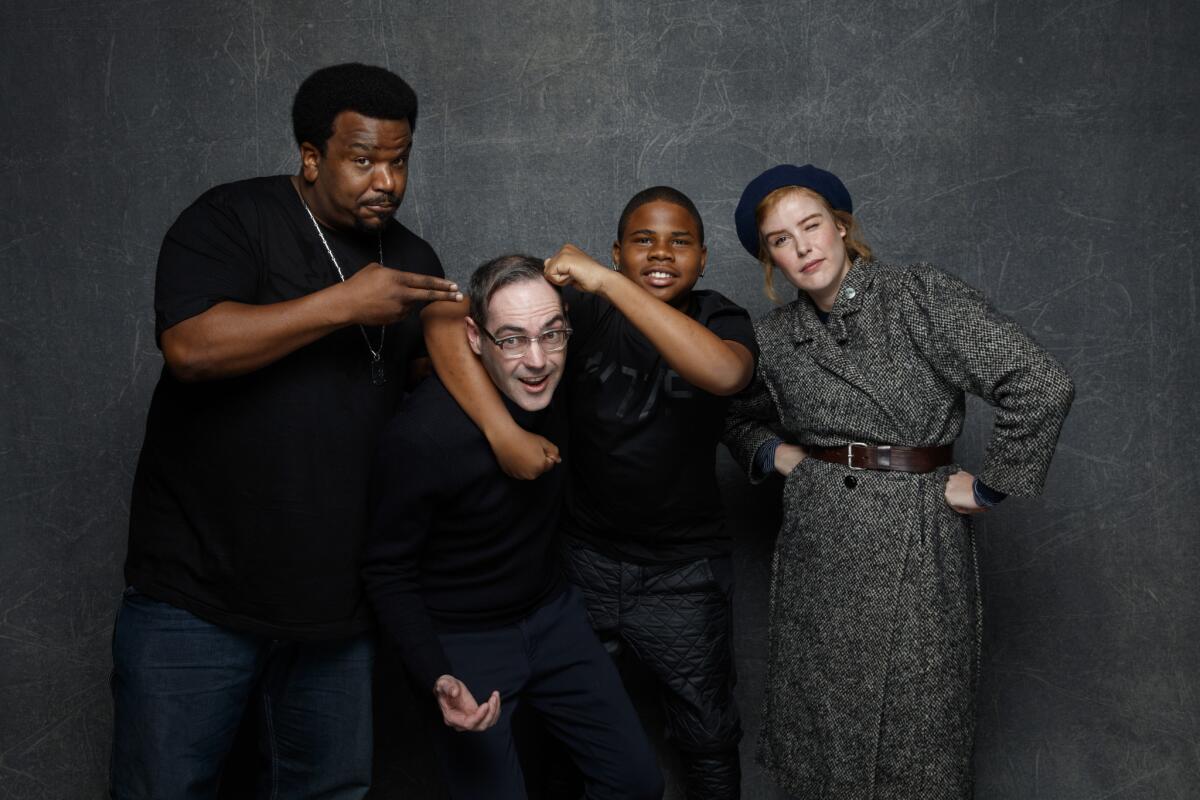
Actors, directors and more, including the “Morris from America” crew, swung by the L.A. Times’ Sundance photo studio.
- Share via
The director of ESPN’s ‘O.J.: Made in America’ finds new ground on Simpson
The O.J. Simpson affair would seem to have long ago worn out its media welcome. Each news special, documentary and tell-all book has, in the two decades since the so-called trial of the century, increasingly wore us down. As if all that weren’t enough, FX will soon air the fact-based dramatization “American Crime Story: The People v. O.J. Simpson.”
As it turns out, there is another tale left to tell. And it’s a doozy.
- Share via
Sundance kicks off with ‘Other People,’ Twitter hyperbole
After the unveiling of any big movie at a premiere or film festival, you see the phone screens begin to flicker. Mere seconds after the credits roll, journalists are sharing their reactions on social media -- eager to be one of the influencers whose insta-opinion shapes public sentiment about the film.
That’s particularly true at Sundance, which kicked off Thursday evening with the feature film “Other People.” The movie, written and directed by “Saturday Night Live” and “Broad City” scribe Chris Kelly, follows a twentysomething (Jesse Plemons) who moves back to Sacramento to aid his mother as she battles cancer (Molly Shannon).
Shannon, in particular, gives a gut-wrenching performance -- one that has her alternately wretching and weeping -- and the turn prompted some audience members to declare the “SNL” vet a 2017 Oscar contender.
While that seems a tad premature, many audience members did seem emotionally moved by the film. A few dozen filmgoers rose to their feet to applaud the filmmaker and cast post-screening, a move that was described by some on Twitter as -- shocker! -- a standing ovation.
In a Q&A after the movie was finished, Kelly told the crowd that the film was based largely on his own experience, noting how he hoped to capture the dichotomy of “laughing so hard” with his own ailing mother and then “filling out end-of-life paperwork.”
“Death isn’t just sad all the time,” he said, before thanking the audience and filing offstage.
Meanwhile, online, other people -- ugh, I’m sorry, blame it on the altitude? -- were sharing their opinions on the film. And they weren’t as kind.
Ah, good ol’ Sundance -- where you can never really tell if a film is a potential Oscar contender or a cliche-filled mess.
- Share via
Unlike the Oscars, Sundance offers a bevy of movies with black protagonists
The Sundance Film Festival wasted little time diving into the diversity debate Thursday when reporters asked co-founder Robert Redford how he felt about the #OscarsSoWhite controversy currently roiling Hollywood. Redford demurred and said diversity was always a key goal of Sundance. Judging by this year’s slate, he had a point.
The Oscars may be lacking in black stories and personalities, but not so at Sundance. Here are five movies set to play Park City in the coming days that underscore the festival’s role as a place for minority-centric storytelling. This isn’t an exhaustive list by any stretch, but it suggests some of the offerings on display.
“Birth of a Nation.” No, the title is not an accident. In re-telling the story of Nat Turner’s 1831 slave rebellion, director-star Nate Parker has cleverly appropriated the title of D.W. Griffith’s racist propaganda epic to offer his take on black empowerment. Two years ago at this time “12 Years a Slave” was rolling through award season. “Birth” returns to that antebellum period, this time telling a different story of slavery—and heroism and resistance.
“Michael Jackson’s Journey From Motown to Off the Wall.” The subject of a hugely successful 2009 concert film, Michael Jackson again gets the nonfiction treatment on the big screen. The man behind the camera is none other than Spike Lee, a collaborator and longtime fan of Jackson’s. Here, he looks at the earliest days of Jackson’s career as part of a family ensemble all the way through the titular 1979 solo album.
“Miles Ahead.” Already a hot and at times polarizing conversation piece when it premiered at the New York Film Festival this past fall, Don Cheadle’s unconventional biopic of Miles Davis is likely to set tongues wagging again. In telling the story of the jazz legend, Cheadle eschews biopic convention, and even the facts as we know them. instead, he uses a loose, riff-y style befitting his subject, even veering into blaxploitation and heist-movie tropes to tell his tale.
“The Fits.” Dancing and boxing don’t often go together, but they do find common cause in this movie. Directed by the up-and-comer Anna Rose Holmer, “The Fits” centers on an 11-year-old fighter (an on-the-cusp Royalty Hightower, seen above) who is fascinated by dancers when she sees them practicing at her boxing gym and sets off on a journey of exploration. Female African-American coming-of-age stories have offered some strong Sundance dramas in recent years--Dee Rees’ “Pariah” is one such film that comes to mind--and hopes are high “The Fits,” which earned strong reviews out of Venice in September, continues the tradition.
“O.J.: Made in America.” You’d think you’ve seen all there is to see about O.J. Simpson, with the trial now more than 20 years in the rearview mirror. You’d be wrong. In his epic 7 1/2 hour project set to air later this year on ESPN, documentary veteran Ezra Edelman turns the story of Simpson into a tale of race itself, both in Los Angeles and America at large. You’re likely to emerge thinking of the bloody glove, Mark Fuhrman and the trial’s other trappings differently--for one thing, as a lot more than just a trial.
- Share via
‘Guns, bombs, grenades?’ Security check at this year’s Sundance has heightened
Gun violence isn’t only a theme of several movies this year, as Steven Zeitchik writes. It’s also top of mind at the festival.
- Share via
Our #LATphotostudio is up and running!
- Share via
Our photographers set up the L.A. Times photo studio
- Share via
‘Holy Hell’ shows you what a cult looks like from the inside
Debuting Monday as part of Sundance’s U.S. Documentary Competition, “Holy Hell” is Will Allen’s first-person story of the 22 years he spent in a West Hollywood cult led by a charismatic “teacher” and promising enlightenment, an experience that started out euphoric and ended up divisive and sexually exploitative.
Because “Holy Hell” is told largely via extensive footage Allen shot at the time, the film has the uncanny effect of showing us what a cult looks like from the inside, how appealing it can be to those seeking enlightenment, and with after-the-fact interviews how bitter the aftermath can feel if things fall apart.
Do you know what Joseph Campbell wrote about the hero’s journey? It’s the return that’s the hardest part, reintegrating into the world, but it’s so important. The hero adds value by telling what he found, and that’s the value I have right now, with this story, this film.
— Will Allen
- Share via
Robert Redford touts Sundance diversity but holds tongue on #OscarsSoWhite
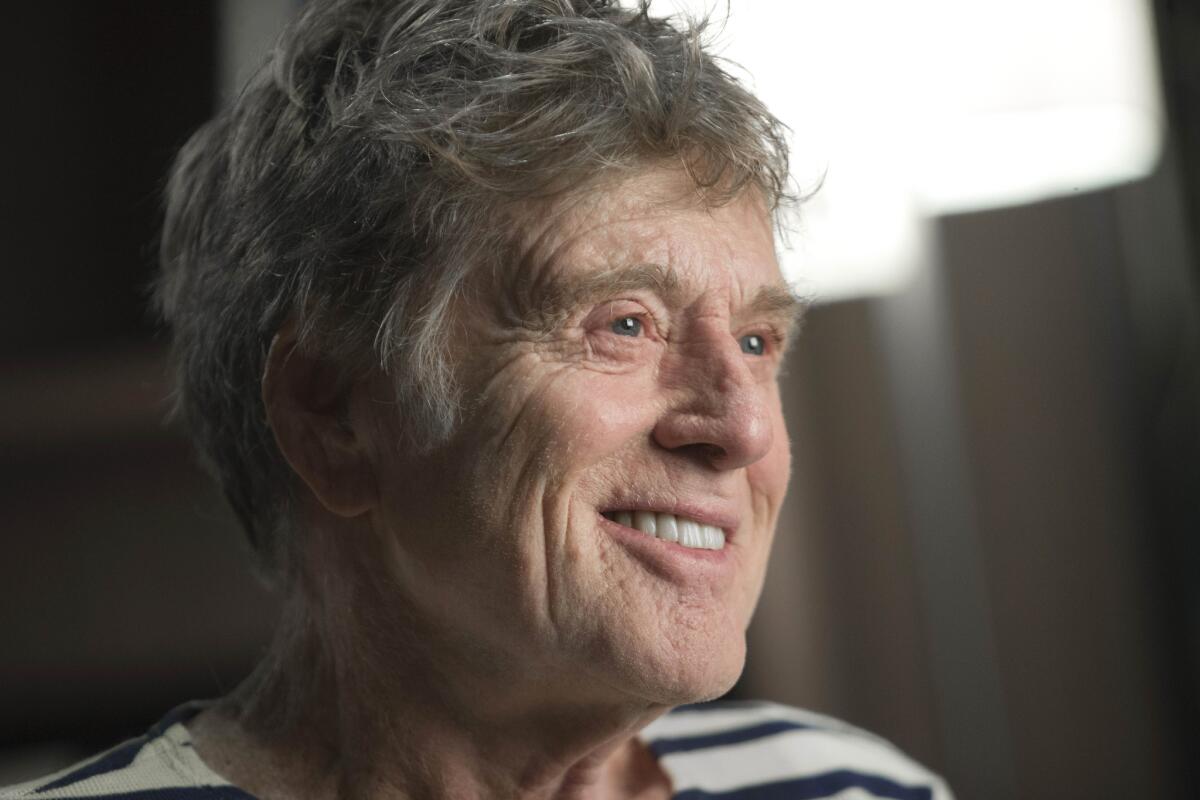
I’m not into Oscars...I’m not focused on that part. For me, it’s about the work.
— Robert Redford, Sundance founder
With the #OscarsSoWhite controversy boiling over in Hollywood, Sundance Film Festival chief Robert Redford took the podium here Thursday and affirmed the festival’s role as a place for diverse stories but declined to jump into the fray.
“Diversity comes out of the word independence — that’s the principal word that we operate from,” Redford said when asked about Sundance’s role in promoting diversity. “Generally, it’s something we’re pretty proud of.”
The Motion Picture Academy has come under fire for not nominating white actors in any of its performance categories this year. The Sundance co-founder spoke in general terms about the importance of minority representation but declined to engage directly with the question of Academy Award nominations. When pressed further on the issue of the snubs, he and Sundance director John Cooper demurred.
“Why are you asking us?” Cooper said with a small smile.
“I’m not into Oscars,” Redford added, perhaps cheekily. He added later, “What I mean is, I’m not focused on that part. For me, it’s about the work.”
As a venue for voices outside mainstream Hollywood, Sundance has prided itself on movies from black filmmakers and black performers. Among the movies it has premiered in that vein in recent years are “Dope,” “Fruitvale Station” and “Beasts of the Southern Wild.”
Redford was careful to draw a line between showcasing those movies and taking a more activist position.
“The artists are making films about what’s on the public’s mind ... and because we’re in support of the artists we say, ‘Well, what do they come up with?’” he said. “We don’t take a position of advocacy.”
Diversity will be on the minds of both filmmakers and attendees during the nation’s preeminent film festival for the next 11 days. The festival will screen work from a range of black filmmakers and performers, which is sure to further the heated diversity debate already happening in Hollywood.
- Share via
The Jonas brother movie you have to see, plus five other recommendations
OK, so “Goat” stars a former Jonas brother. But don’t write off director Andrew Neel’s fraternity brother drama just because lead Nick Jonas also happens to be a pop crooner. The film, about a college student who faces abusive hazing while pledging a frat, may raise timely questions about modern-day masculinity.
Here are five more movies I think you should brave the elements for:
- “O.J.: Made in America”
- “Manchester by the Sea”
- “Weiner”
- “Certain Women”
- “The Birth of a Nation”
- Share via
The scene at Sundance

It’s a winter wonderland in Park City, Utah for the Sundance Film Festival. Check out more photos here>
- Share via
Fiction collides with reality for ‘Tallulah’ creator Sian Heder
“Tallulah” is a story born from real-world experiences that is nevertheless tinged with magical realism. It’s also a film in which the themes on-screen were in no small way mirrored by the off-screen saga of creating it.
Premiering at Sundance as part of the U.S. Dramatic competition, the film is the feature debut for writer-director Sian Heder. The story is an expansion of her 2006 short film “Mother,” and Heder has in the intervening years pursued a burgeoning career in television, most notably as a writer and producer on “Orange Is the New Black.”
The story of “Tallulah” found its inspiration in a time in her career when Heder worked as a nanny for hire, often at upscale Los Angeles hotels to look after the children of wealthy guests for a few hours. When one woman struck her as a particularly unfit and disinterested mother, she wondered what would happen if she kept the baby for herself. “Tallulah” explores that possibility.
- Share via
Paparazzi travel to Utah to snap celebs at Sundance
OK, so I just landed in Utah, and I’m all prepared for a change from the L.A. scenery. You know -- snowy mountaintops, brisk air, puffy coats. But minutes after I exited the plane at the Salt Lake City airport, I was confronted by something very Hollywood: paparazzi.
Right as I walked into the baggage claim area, I spotted half a dozen twentysomethings with big cameras camped out at a table. One dude was even wearing a hat that said “PAPLIFE.” (Check him out on the far right in my picture above.)
That was Keith Johnson, a 22-year-old independent photographer who flew from California to Utah for the festival, which kicks off on Thursday. He spent today in the airport and told me he got pictures of Sarah Michelle Gellar and former Playboy bunny Kendra Wilkinson.
This is the first time Johnson is covering Sundance; he said he flies to New York to snap celebs during Fashion Week and the Met Gala. He plans on hanging out at the airport for three days, and then he’ll drive the hour up to Park City, where the festival takes place.
In all, he expects his six-day trip will cost him about $700. But he said he typically makes about $40 a pop on a celebrity picture -- and if he sells 10-15 shots a day, that’ll add up.
“I really want to get Kristen Stewart -- she’s a big name,” he said. “Or Daniel Radcliffe.”
“You’re not worried they’ll fly private?” I asked.
“Not really,” he said with a shrug. “Anyway, my guys on the other side at LAX will tell me who is leaving to come here.”
- Share via
Will Sundance move the needle on gun control?
There were more than 40 mass shootings in the United States last year, prompting many politicians to hold forth and a large number of Americans to simply shake their heads. What needed to happen, they asked, for these tragedies to stop?
Now a new group is entering the debate: independent filmmakers.
You can be callous in looking at news stories in a way you don’t when you’re watching a film. That’s why I think these movies can really help change the way you think.
— John Cooper, Sundance Film Festival director
When the Sundance Film Festival begins Thursday, it will do so with a rare accumulation of movies about the subject of gun safety. All of them hope to raise questions, if not provide solutions, in a place that has long been a ground zero for cultural movements.
Here’s a look at those movies and what the filmmakers have to say about them. >
- Share via
How to hail a helicopter at Sundance
Uber has partnered with aircraft manufacturer Airbus Group SE for a pilot program that will let Sundance attendees hail a helicopter ride from the Uber app.
- Share via
The films crowds will be showing up for
“Agnus Dei”
A skilled director (France’s Anne Fontaine) takes on a potent story based on events in 1945 Poland: Nuns who’ve become pregnant after being raped by rampaging Russian soldiers turn in desperation to a young French female doctor for both medical assistance and their fears of being damned.
“Certain Women”
Indie veteran Kelly Reichardt finely adapts three elegant, exactly written short stories by Maile Meloy for an evocative, modulated film starring Laura Dern, Kristen Stewart and Michelle Williams that deals with the human need for connection amid the persistence of loneliness.
“Indignation”
Screenwriter and film executive James Schamus has chosen for his haunting directorial debut a disturbing late Philip Roth novel set against the Korean War about the relationship between an inexperienced college freshman and a beautiful but tortured blond transfer student.
“Sand Storm”
A different side of Israeli society is featured in this moving story of a mother and daughter in the Bedouin community who are caught in different ways between tradition and modernity when the head of the family takes a second wife.
Continue reading for more noteworthy dramas at the festival>
- Share via
Sundance’s competitive field
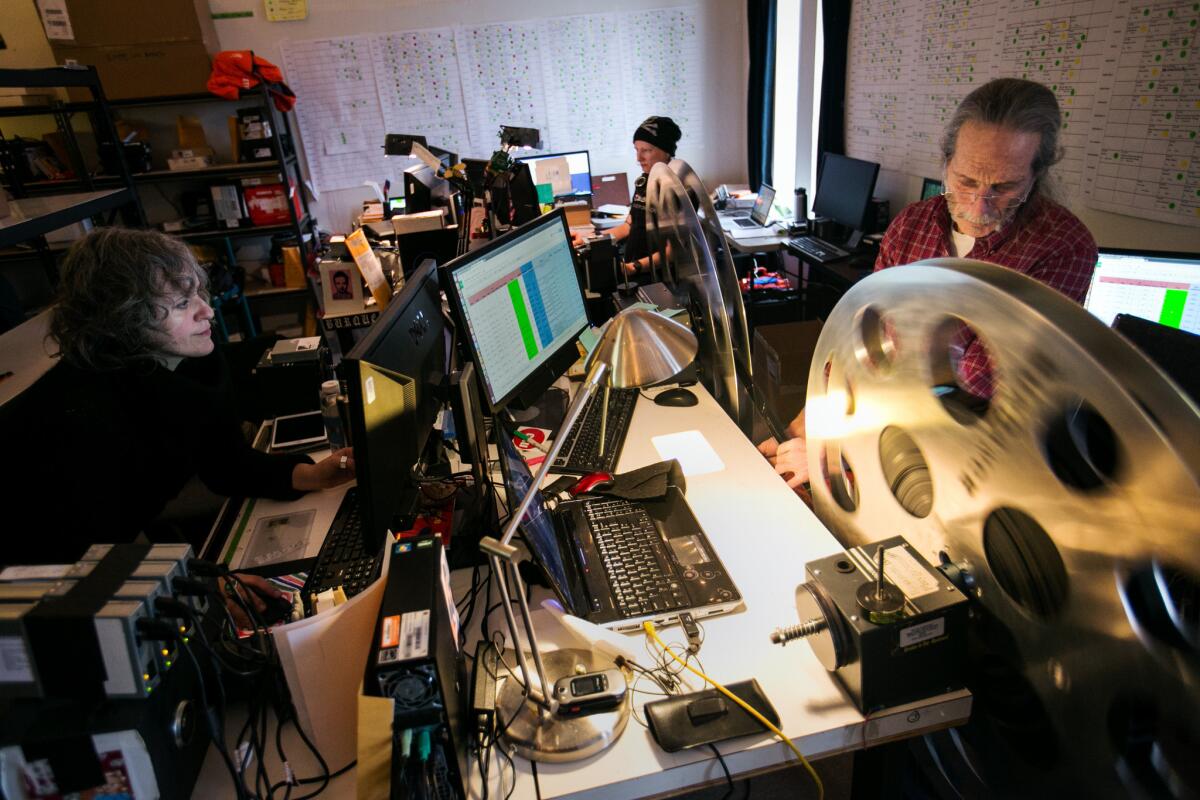
This year, the flood of films vying for one of Sundance’s 123 feature slots became, if anything, more intense, with 4,081 submissions (1,972 from the U.S., a whopping 2,109 from overseas) entering the chase. Better odds than the Powerball, but still a daunting proposition.